CONTRIBUTIONS FROM:
Teal Thibaud Tara Poole Mallory Baches Veronique Bergeron Liza Soydan Design: Tiny Giant

GLASS HOUSE COLLECTIVE WAS FOUNDED TO BRING LIFE BACK TO GLASS STREET, AND GLASS STREET BACK TO LIFE. The following is the story of that work.
DEAR FRIENDS, THIS DOCUMENT SUMS UP TEN YEARS OF SHARED WORK IN THE GLASS STREET NEIGHBORHOOD. TEN YEARS OF COMMUNITY CELEBRATIONS BIG AND SMALL, NEIGHBORHOOD EVENTS BOTH PLANNED AND IMPROMPTU, COLLABORATIVE CREATIVE PROJECTS THAT SUCCEEDED BEYOND OUR WILDEST EXPECTATIONS, AND CO-CREATED PLANS THAT MAY TAKE AT LEAST ANOTHER
DECADE TO BE REALIZED.
While this report is a look back, I hope you’ll read it as I do -- as a look forward, a rough roadmap for a future in progress. This isn’t just a set of conclusions; it’s also one big beginning.
sharedneighborhood. work in the sumsuptenyearsof Thisdocument GlassStreet
When Katherine Currin, Garth Brown, and I began working here in 2012, Chattanooga itself was already in a period of transition, basking in plenty of glowing national press and watching its regional economy boom.

Even then, the good news and economic growth seemed to be accruing in a few particularly well-favored parts of town, especially the trendy Southside and North Shore neighborhoods. East Chattanooga districts like those around Glass Street were rich in history and historic buildings, but short on momentum and prospects for investment.
The questions we were trying to answer then are in many ways still unresolved, along Glass Street and in similar neighborhoods throughout the country. What does successful redevelopment and revitalization look like in urban neighborhoods? New stores and eateries on every corner? New apartments to absorb large numbers of new residents? New parks? What about new schools?
More specifically: who should be responsible for making these plans and putting them into action?
As I look back, I’m grateful that our plans didn’t turn out the way we initially thought they would. A neighborhood can develop quickly if the people who live there aren’t at the helm of every decision, but that isn’t true community development. It’s colonization. I’m enormously proud of the storefronts we renovated, the streetlights we installed, the parks we built, the temporary and permanent art installations, and the new businesses that have opened here in the last decade.
Building capacity, connections, and relationships may not be real estate stories, but they are real stories, and they are what make a community.
FROM THE BEGINNING, GLASS HOUSE COLLECTIVE WAS AN EXPERIMENT.
The idea of having arts and culture at the table of neighborhood change was new to Chattanooga, and new to us in this place. But we felt sure that, as a collective, we could create an even stronger sense of place and belonging alongside our neighbors. People with incredible skills and talents waiting to be accessed were already here. Individuals ready to roll up their sleeves and put their gifts to work jumped on board. When we listened to our neighbors and met them where they lived (often on their front porches!), we heard a story about the hopes and dreams of this community that was undeniable in its power. We needed the patience and humility to learn first and do second. When we did that, great things happened.
Great things are still happening. The last ten years on Glass Street taught us a lot, some of which I hope we have captured here. The only way to really understand what we’ve achieved and what we have yet to achieve is to visit the community. As much as this document is a report, I hope you’ll also consider it your invitation from all of us who love this community. Come to Glass Street. Visit the shops and businesses. Enjoy the public art. Get to know the people who live here. I did, and it changed my life.
LET’S KEEP DREAMING, BUILDING, GROWING, AND CREATING TOGETHER.
With Love,
Teal Thibaud
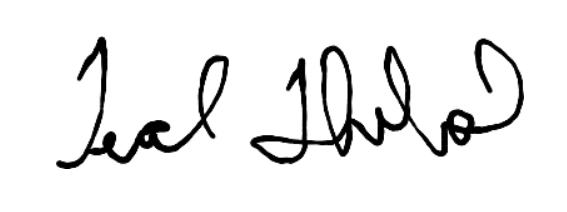
WHILE THIS REPORT IS A LOOK BACK, I HOPE YOU’LL READ IT AS I DO -AS A LOOK FORWARD, A ROUGH ROADMAP FOR A FUTURE IN PROGRESS.
THIS ISN’T JUST A SET OF CONCLUSIONS; IT'S ALSO ONE BIG BEGINNING.
....................................................................... ....................................................................... ....................................................................... TABLE OF CONTENTS // 7 Contents ....................................................................... BACKGROUND 8 COMMUNITY 10 CREATIVE PLACEMAKING 18 COLLECTIVE IMPACT 40 REFLECTIONS 74 .......................................................................
GLASS STREET AND THE GLASS FARM NEIGHBORHOOD




Glass Street is a two-lane commercial corridor with 1920s storefront architecture that runs through the heart of the historic Glass Farm neighborhood in East Chattanooga, Tennessee. During its rich past, Glass Street was the vibrant, bustling focal point of the surrounding community, with a theater, restaurants, and retailers lining the neighborhood main street.
The neighboring residential streets have wonderful views of adjacent Missionary Ridge, with a crest rising over five hundred feet above the community and adding to the already unique topography of the area. In addition to being near protected state and federal lands, the Glass Farm neighborhood is nestled between the Battery Heights, Avondale, and Boyce Station neighborhoods.



The intersectional role that Glass Street plays, combined with the adjacency of Glass Farm to surrounding neighborhoods, results in a recognizably larger community that defies a single neighborhood, zip code, or census tract classification. Once humming with manufacturing jobs, this broader nextring community has retained a small core of residents and businesses that have pride and ambitions for their often overlooked and underestimated area of town.


BACKGROUND // 9

Community
The community represents the single greatest asset in the Glass Farm neighborhood...
...yet residents had not historically received a seat at the table to drive improvements and affect change, creating a sense of vulnerability and mistrust.
Coupled with decades of limited outside investment, this resulted in a collection of economic, social, and infrastructure challenges that demand strategic and deliberate response. With a commitment to a shared vision and a stronger community, the partnership of a non-profit and a neighborhood vision was able to take root.
COMMUNITY // 11
Community Insights
NEEDS & CHALLENGES
Early in this work, consistent themes emerged from conversations with community residents - the hope for a cleaner, safer, and more inviting neighborhood. We heard about the importance of having access to goods and services within the neighborhood. We learned that the needs of the community were varied, and often interrelated.
These conversations also surfaced the immense economic, social, and infrastructural challenges the neighborhood faced. Obstacles to safety and development were many: vacant and underutilized land, abandoned buildings. A deficit of public investments in streets, shared spaces, and amenities made it difficult to realize the cleaner, safer, and more inviting neighborhood that residents wanted. Similarly, these barriers reduced the likelihood of new commercial tenants that could provide access to goods and services moving into the neighborhood.
We set to work with residents to address the needs and challenges identified. When the themes from our early conversations were echoed in a 2016 Habitat for Humanity survey of Glass Farm residents’ opinions and experiences, we knew that we needed to double-down on our efforts.

ASSETS & OPPORTUNITIES
Our early conversations and the 2016 survey combined to increase our appreciation for Glass Farm’s greatest assets...its residents, their relationships with each other, and their pride for the community.
The 2016 survey found that: 77% of residents were somewhat-to-very satisfied to live in the neighborhood, and 78% would probably-or-definitely recommend the neighborhood as a good place to live.
We also observed that 30% of built structures in the neighborhood were zoned for commercial use, and with its historic commercial corridor that links Chattanooga’s thriving downtown and the Enterprise Industrial Center, the neighborhood could be well-positioned for an increase in commercial tenancy and residents’ access to large area employers. In either direction, employment opportunities can be found at major companies like Volkswagen, Amazon, TVA, and UNUM.
However, to our residents, these places feel a world away – as opposed to the actual mere miles. Chattanooga had started a renaissance, but it had stopped short of East Chattanooga. In 2012, we committed with an intention of contributing our creative placemaking knowledge and knowhow to work with the community. To this day, that commitment has not waivered.
A follow-up survey conducted by Habitat for Humanity in 2019 showed some early indications of change in Glass Farm residents’ opinions and experiences. As an important example, the proportion of residents somewhat to very satisfied with living in the neighborhood increased to 92% from 77% in 2016. We believe that this work is making an impact in the community; we want to see that impact continue to increase and expand.

COMMUNITY // 13
GlassCollectiveHousewas bo rn out of a Strong tradition ofvisioning.community
Decades ago, residents galvanized to turn what Walter Cronkite called “the dirtiest city in America” into the Chattanooga of today. And while corners of the city are cleaner, safer, and more engaged as a result of homegrown revitalization, transformation has not always been equitable.
To put it simply: there was still work to be done.
Fast-forward to 2009, when a new generation of community builders set out to understand the needs of Chattanoogans through STAND, the world’s largest community visioning effort, which asked over 25,000 residents to prioritize areas of opportunity, growth, and redevelopment.
These results, combined with insights from a City Research and Development Workshop hosted by GOOD Magazine, helped community builders identify the Glass Street corridor as a candidate for investment. As a direct route between downtown and Enterprise South — a major economic hub that hosts Volkswagen and Amazon facilities — Glass Street was perfectly positioned as the city’s next great redevelopment success story. While the area was heavy with economic challenges and carried a reputation of being abandoned and dangerous, its history was rich.

COMMUNITY // 15
THE NEXT STEP FELT SIMPLE: TAKE THE PRINCIPLES OF ARTISTIC, ECONOMIC, AND CULTURAL DEVELOPMENT THAT HAD WORKED SO WELL IN OTHER PARTS OF CHATTANOOGA AND TRANSPLANT THEM ON GLASS STREET UNDER THE BANNER OF GLASS HOUSE COLLECTIVE.


TURNS
OUT, IT WASN’T THAT SIMPLE AT ALL.
Armed with big ideas and good intentions, we set up shop in the Glass Farm neighborhood in 2012 only to find that our lessons from elsewhere didn’t apply — and that our neighbors weren’t interested in redevelopment from the outside in. And they were right: well intended or not, taking lessons from a different cultural and economic context and applying them to an area we’d only just begun to engage with missed the mark. So instead, we followed in that same proud tradition of visioning, but this time, with our eyes and ears and hearts trained on the residents of Glass Farm.
As we listened, we started to understand the mistrust that our neighbors had felt: while the community’s greatest assets are its people, their voices had been historically and systematically overlooked when it came to driving improvements in their own neighborhood.
Coupled with decades of limited investment, the result was a growing list of economic, social, and infrastructure obstacles that continued to inhibit reinvestment.
Glass Farm residents wanted a seat at the table in fixing these issues, but they hadn’t historically been invited or even considered in development conversations.
So as a first step, we took a seat with them: on front porches, at kitchen tables, on park benches, and more. Listening, building trust, and identifying opportunities for homegrown revitalization.
In 2013, we reopened under a new mission with a new goal: to bring life back to Glass Street, and
Glass Street back to life through artist-led and community-involved projects.
Just like the residents who had always called this place home, we felt pride in the 1920s architecture that lined the commercial corridor, and in the incredible community spaces and assets surrounding the area: the history, story, potential, opportunity, reality, and above all, the people of Glass Farm. We were in love.
And over the past decade, we have worked with our neighbors on a shared mission to make Glass Street cleaner, safer, and more inviting so that more people and businesses can tap into that place-based love. We’ve expanded our focus beyond a single corridor to engage a larger part of East Chattanooga, and we are looking towards a future that grows on the lessons learned by doing this work with this community.
COMMUNITY // 17
Creativeplacemaking

Creative Placemaking:
(active verb):
The process of engaging artists, arts organizations, and community development professionals to integrate arts, culture, and creativity into community revitalization projects.
CREATIVE PLACEMAKING // 19
What We Believed
THE CREATIVE PLACEMAKING APPROACH

ARGUES THAT WHEN YOU BRING CREATIVES INTO CONVERSATIONS AROUND LAND USE, TRANSPORTATION, ECONOMIC DEVELOPMENT, EDUCATION, HOUSING, INFRASTRUCTURE, PUBLIC SAFETY, AND SO MUCH MORE, THE RESULTS HAVE A MULTIPLIER EFFECT.
At Glass House Collective, our work is place-based and arts-obsessed, using community-centered processes and conversations to integrate all the goodness that creative problem-solving delivers. Most importantly, we design “with” instead of “for” the community, and recruit partners that understand the cultural and economic context of our community.
We have been doing the work of creative placemaking for over a decade — which means that we have become good at explaining exactly what it is we do. And we get it: as an emerging practice that’s constantly evolving, this kind of work isn’t always very well understood.
OUR ELEVATOR PITCH IS PRETTY STRAIGHTFORWARD, THOUGH: AS PLACEMAKERS, WE ARE IN A CONSTANT EFFORT TO LISTEN, RESPOND CREATIVELY, AND LEARN TOGETHER.
CREATIVE PLACEMAKING // 21
Listen
Listening was the first powerful lesson that our Glass Farm neighbors taught us when we began this work. Listening ensures that placemaking is always people-forward. While we had a shared vision for a cleaner, safer, and more inviting neighborhood, we all had different strategies for achieving it, and every person’s definition of success is always worth listening to.
Respond Creatively
The heart of responding creatively is simple: answer challenges with unexpected solutions dreamed up by artists, entrepreneurs, residents, and all those creative people that help authentic placemaking happen. For Glass House, this meant being community-led and artistinvolved at every turn.
Learn Together
We know from experience that it’s not about getting it right, right away, but about piloting, testing, improving, and then doing it all again. We believe this process taught us invaluable lessons, and that an approach that doesn’t accommodate for both success and failure will never truly serve our community.



How We Worked
WHAT DID WE DO EVERYDAY? SIMPLY PUT, WE HELPED MAKE CHANGE HAPPEN.

But more specifically, we convened, facilitated, planned, communicated, advocated, connected, organized, recruited, supported, partnered, partnered again, partnered a lot, brewed coffee, hyped our neighbors, hosted Zooms, and most importantly, just did what the community needed to move their work forward. Our greatest investment was time — time spent with people, creating processes and plans, and launching projects, programs, and partnerships.
Our theory of change was based on an interwoven strategy demonstrating Participation, Planning, Partnership, Proof, and Pride , working together in a constant cycle rather than a linear timeline. This continual process of making and re-making change fuels engagement, champions smart problem-solving, and helps us learn crucial lessons by doing.

CREATIVE PLACEMAKING // 25
RESIDENT-LED COMMUNITY DEVELOPMENT
Supporting a grassroots resident-led team to make the community cleaner, safer, and more inviting.
PROJECT GOALS
• Create a paid resident-led platform to lift up neighborhood leadership
• Identify outlets and provide resources for residents eager to create change
• Support peer-to-peer relationships among community change agents
CHALLENGE
Early on we learned from our neighbors that community change can be hard to initiate and might even seem like a threat, especially if it was being initiated by folks who didn’t live in Glass Farm. We understood that there were invested neighbors who had put their hearts and souls into developing the community over the years, yet we also acknowledged that every community is always evolving, and that including new voices along with longtime advocates would be key to achieving the vision that we were hearing our neighbors describe. We had to find a way to bring that past and future together in the present with people who were willing to put in the work.
TACTIC
We created an outreach team of nine individuals eager to join together and become more involved in neighborhood revitalization, who coined themselves the Good Neighbor Network (GNN). Each member received an honorarium for one year and committed to a minimum of 20 hours of volunteer community service.
DETAILS
The team received a modest annual budget of $5,000 to create programs and events that they knew would benefit the neighborhood. In its first year, local resident Enora (Nori Nori) Moss led the group through a strategic planning process where the network identified their top three priorities for these programs: safety, inclusion and information sharing, and beautification.
TAKEAWAYS
Since it was founded in 2013, participation in GNN has nearly tripled, becoming a trusted community resource for Glass House Collective as well as a space for residents to connect and support homegrown redevelopment and community engagement ideas. Members of GNN have been able to share their passion for the neighborhood and put that passion to work as a team, and the results have proven to be amplifying and empowering.
Like with any structure, the foundation is only as good as the ongoing reinforcement it receives; as challenges from funding shortages to pandemic limitations have presented themselves, the group has been forced to adapt and the work has been forced to adjust, though the original goal of supportive neighbor-to-neighbor outreach remains strong. The built-in flexibility of the organic framework of GNN has meant that, as leadership has transitioned and resources have changed, the group has been able to adjust while remaining responsive to its fellow neighbors and their goals for the community.
Participation
Lessons learned
FROM RESIDENT TO ENGAGED CITIZEN
It's sometimes said that change moves at the speed of trust. We believe that until residents become involved and invested in the outcomes of this work, real progress won’t be made.
SURVEYS DON’T SAY IT ALL / DO IT ALL
We also believe that a survey can only go so far. It’s critically important to have face-to-face conversations with neighbors on an ongoing, casual basis, and most importantly: to demonstrate follow-through.
WHAT WE ACCOMPLISHED
Neighborhood action group established (Good Neighbor Network) with 8 founding leaders

Letters and petitions for CDBG funding allocation for new sidewalks and trees
Resource guide created by residents to share with residents
Resident-led events bringing the community together (Parti Gras, May Day, youth etiquette dinners, Christmas parties, cleanups, decorating events)
Updated mission statement to include making Glass Street and the surrounding neighborhoods cleaner, safer, and more inviting
Little Free Library, recently added to the national registry Involved in ongoing meetings
SWAY cohorts to graduate
Art Means Business grant program co-created with residentled Advisory Committee
SWAY community organizing classes held
Founding leaders of the Glass House Collective Advisory Council
of Participants, Volunteers, and Partners supporting residentled & driven initiatives

Community organizing curriculum created in partnership with CALEB
Glass House Collective Advisory Council launched in 2020 1
Advisory committee formed to choose 3 artists for the Artist Residency program
Advisory committee formed to choose the bus shelter and bench art in partnership with Public Art Chattanooga
8 1 1000s 1 2 16 20 1 1 1 1 600+ 1 1
29
COMMUNITY-ENGAGED DESIGN WORKSHOPS
Bringing small ideas with big impact to life across the breadth of neighborhood needs through community-engaged design.
PROJECT GOALS
• Activate planners and doers from across the neighborhood, city, and country
• Create a library of creative, realistic, and scalable ideas
• Implement ideas that resonate with the community
CHALLENGE
Glass House Collective always valued the importance of neighborhood planning, from its launch on the heels of the Tennessee AIA conference in 2012 when community leaders and practicing architects workshopped what the design and development opportunities they saw for the Glass Street corridor. Three years later, we had completed our “To-Do” list but were struggling to chart our future. We needed a new strategic plan but weren’t sure where to start.
TACTIC
Revisiting the tool of community-engaged design workshops, in April 2015 GHC hosted its own urbanism conference, called “The Next Big Thing.” This workshop brought local leaders and outside experts together with residents to assess our neighborhood’s needs and provide multi-faceted and creative solutions, for both the short- and long-term.
The goal was simple: develop creative, scalable, realistic ideas. We had a collection of architects, designers, park planners, artists, teachers, store owners, photographers, and neighbors divided into nine teams, each with a diverse set of backgrounds, expertise, and relationship to Glass Street.
DETAILS
Teams were asked to consider how improved urbanism could have a positive impact on the neighborhood by increasing business viability, quality public spaces, access to services, housing options, public safety, and opportunities for the community to engage and contribute.
What resulted were dozens of creative, realistic, and scalable urban revitalization tactics for improving residential, commercial, and public spaces within a 5-minute walking radius surrounding historic Glass Street. Designs specifically addressed implementation within one-month, one-year, and three-year time frames.
TAKEAWAYS
To ensure that the projects coming out of the workshop aligned with the community’s goals, GHC compiled the ideas and hit the streets to find out which projects were most important to community members. We used the community’s priorities to create our next work plan, with three years worth of short and long-term goals. The short-term goals were then collected in a How-To Guide including directions, materials, and tools for projects that could be implemented within one month: eight ‘lighter, quicker, cheaper’ projects that are replicable, scalable, and affordable.
Planning
Lessons
STEP 1: TEMPORARY; STEP 2: PERMANENT
While we know the importance of permanent improvements, making “the case for change” has more impact through imaginative, temporary installations and experiences that can be done in a month or even just a week of work. This strategy helps organizations gauge the real interest of their communities and show proof of what’s actually possible.


DESIGN FOR EVERYONE DESIGN WITH EVERYONE
It’s been said that
is for everyone, but we’ve learned that design is for everyone only when it’s with everyone. Professionals may bring expertise, but neighbors bring the crucial experience of living in their community. When every neighbor or partner has a say in design, it’s no longer a prestige product: instead, it becomes a strategic tool for progress.

learned
WHAT WE ACCOMPLISHED Design professional workshop attendees overall Projects implemented by community members of community meetings How-To Guides published and implemented Streetscape and Public Space Plans Feature articles in Next City and Architect Magazine Urban Planning workshops Exhibit in the Cooper Hewitt Museum Feature articles in the New York Times 24-hr deep-dive planning workshop 21 25 50 2 2 2 4 1 2 1 218 Big ideas presented Urban design planning meetings & community-led dinners 100 s
design
SUPPORTING RESIDENTIAL IMPROVEMENTS
Partnering with residents, local volunteers, and organizations in order to expand redevelopment from the commercial core to the residential base of the neighborhood.
In the process of being “on-site” with our neighbors during community volunteer days, it became clear that we would need a partner that could handle extensive building improvements, like installing air conditioning systems or repairing falling roofs and porches. These much-needed home repairs, many of which impacted the quality of life of our neighbors, weighed heavily on us. In response, in the summer of 2016 we successfully recruited Habitat for Humanity’s Neighborhood Revitalization Program to Glass Farm, after years of discussion and wishful thinking.
DETAILS
PROJECT GOALS
• Answer the community’s call for more residential-focused improvements
• Expand beyond commercial revitalization to impact the lives and livelihoods of neighbors
• Leverage the help of like-minded partners for shared success and broader impact
CHALLENGE
Building off the insights gained from the community as a result of the multiple urban design workshops that GHC hosted, we saw that our neighbors wanted more than commercial investments. When it came to bringing Glass Street back to life, they also craved programs that helped them tackle residential improvements.
TACTIC
Our first step in addressing this need was the Glass House Collective mobile bike cart, conceptualized and built by local artist Rondell Crier to travel the neighborhood, bringing plans, surveys, and meaningful engagement directly to residents. This allowed us to create relationships with homeowners, listen, and build greater trust with the community.
We launched our partnership during a community event called the “Beautification Blitz,” and over the next three years, Habitat for Humanity worked with neighbors on vital home repairs, landscaping projects, new-builds, and a number of outreach programs and surveys. Neighbors who met the simple application requirements were able to receive the home improvements they needed, seeding a culture of neighborhood selfrevitalization in the process.
TAKEAWAYS
The results of this partnership have been staggering, with Habitat for Humanity going beyond home and commercial repairs to support neighborhood leadership efforts in a meaningful way and build long-term relationships here in Glass Farm. In addition to showing up at events like Glass Street LIVE, helping renovate GHC’s own offices, and installing pride banners around the neighborhood, they organized Neighbor Labor Days where residents could volunteer to help with their own neighbors’ renovation projects — one of the most successful community-building programs to come out of ten years of work on Glass Street.
Partnership
Lessons learned
THE POWER OF THE CONDUIT
As the chief convener for countless projects in our community, our role as an organization was often to simply serve as a connector, passing resources between and among our neighbors, partners, and sources. But that role was a pivotal one, helping to grease the gears of collaboration to empower the change we were all seeking, together.

PARTNERSHIPS TAKE WORK
No matter how aligned interests are, creating a successful partnership takes no small amount of effort from both parties. Different organizational missions lead to different goals, which can mean different measures of success. To combat that problem, communication is key -- at the onset, throughout the process, and even once the work is done -- to ensure that the relationship makes the most of what everyone brings to the table.

WHAT WE ACCOMPLISHED Neighborhood-wide surveys New organizational partnership with Habitat spanning over 3.5 years Neighborhood volunteers activated in direct investment from Habitat for Humanity Commercial repair projects completed Critical home repair projects completed New engaged residents involved in collective work Neighborhood evaluations to chart a better path forward Neighbor Labor events where neighbors would volunteer to work on neighbors' homes 15 5 5 2 1 New homes built, investing $600,000 in the community 2000 6 $ 1 m 20 20
Proof SECURING CAPITAL IMPROVEMENTS
Making a key commercial corridor cleaner, safer, and more inviting through the power of community visioning.
PROJECT GOALS
• Slow traffic and improve walkability on Glass Street, particularly at key intersections and gathering places
• Increase lighting along the corridor to make Glass Street safer and more inviting
• Increase public investment in the Glass Farm neighborhood
CHALLENGE
In the second half of 2012, Glass House Collective hosted multiple community meetings where residents, business operators, and property owners expressed a need to make Glass Street safer — from high-speed traffic, from crime, and for pedestrians. The idea of seeing actual change was foreign, so we knew he had to start in a specific place with a specific plan.
TACTIC
Over a three month period, we heard from 150 residents who shared their ideas and hopes for the future of Glass Street and these community needs became part of GHC’s mission: to make Glass Street cleaner, safer, and more inviting by making significant changes to the very infrastructure of the area. The input was compiled into a streetscape plan by David Barlew Architects, which included recommendations for a
pocket park, green space improvements, bus shelters, new tree wells, streetlights, crosswalks, and more at the North Chamberlain and Glass Street intersection.
The plan was unveiled to the community at our annual Christmas Party in December 2012. A few months later, the City of Chattanooga approved the plan, and with invaluable professional assistance of civil engineers from the city’s Department of Public Works, construction began and that capital investment has spread along the corridor. New sidewalks have increased foot traffic and commercial activities; new bus shelters have provided comfort for residents and commuters; and slower traffic has helped keep residents safe.
DETAILS
Importantly, the plan was designed to prioritize the safety of pedestrians over the convenience of motorists, which meant coming up with rigorous recommendations for parking limits and development guidelines. We couldn’t wait on the city’s timeline to show progress, so we replicated the Better Block national model and brought our vision to life over the course of one day. This event created momentum and helped secure more investment as well as involvement and trust from our neighbors.
TAKEAWAYS
The city’s involvement in this revitalization project was unprecedented and signaled a change in how the city interacts with residents. This public investment also laid the foundation for private investment that will provide more commercial opportunities for residents.
ADVOCACY AMPLIFIES
ACCOUNTABILITY IS KEY

learned
Lessons
As
organization
we
to
the
public investment
private investment
organizations.”
a formal
advocating on behalf of our neighborhood,
knew we were invaluable
amplifying
solitary voices of our neighbors. We found that power could act as a catalyst for
that the community demanded, which would in turn spur the
that the community needed. Put simply, “Organizers organize
Streetscape planning isn’t the sort of thing neighbors necessarily
streets for, but capital improvements to a community that has
overlooked can be a significant symbol of
examples
and
partners
accountable, displays
Streetscape plans adopted by the City of Chattanooga Blocks of new sidewalk at North Chamberlain intersection Blocks of new sidewalk at Dodson intersection Community members involved in the 2012 streetscape plan New pocket parks / parklets Large-scale permanent murals GHC Headquarters buildings renovated Lighter, Quicker, Cheaper projects implemented from How-to Guide New pedestrian lights New artistic bus shelters Commercial corridor 'bookends' updated with infrastructure improvements Community members involved in the 2016 streetscape plan Temporary creative crosswalks City installed crosswalks New trails leading to Sherman Reservation National Park Save A Lot new neighborhood grocery store Trees planted New design guideline plan Year of engagement work prior to the City adopting both plans 4 1 8 150 3 3 3 20 26 3 2 250 1 10 2 1 50 1 1 2 More year of work for the City to adopt the second plan (really 3 but who's counting?)
gather in the
been consistently
worth. Studying the needs, showing popup
of what's possible,
then holding
with the power to invest
the community ownership of its own long-term success. BY THE NUMBERS
CELEBRATING THE COMMUNITY
Showcasing the people and places that make this community a neighborhood like no other.
PROJECT GOALS
• Increase pride by highlighting the neighborhood’s distinctiveness, from the inside out
• Showcase the area’s culture through arts, music, food, and activities
• Create leadership opportunities for local residents, artists, and business owners
CHALLENGE
We knew that this neighborhood was full of incredible people, amazing assets, and so much opportunity. We asked ourselves: how do we create a platform that brings people together to celebrate all the good happening here? There’s so much to love about the Glass Street neighborhood, and we wanted to share that with our entire city!
AH HA
Glass Street LIVE is an annual block party that puts our unique culture and way of life on stage for all of Chattanooga to see. This positive, safe, family-friendly event is rooted in the arts, culture, and entrepreneurial spirit of the community. And most importantly, Glass Street LIVE is a yearly reminder that this is a neighborhood worth being proud of.
DETAILS
Glass Street LIVE transforms our central commercial corridor into a vibrant community space where neighbors perform and promote, cook and create. The day is filled with music, local food, live murals, arts activations, and moments for real community conversations. Over the years, Glass Street LIVE has featured gospel and hip-hop acts, spoken word, dance, and even professional wrestling. In addition to participatory activities like screen-printing, living history museums, and dance-offs, each year also includes a tactical urbanism project, like painting crosswalks or streetscaping.
TAKEAWAYS
While each year has been different (the party even lived under a different name in 2013!), the connecting thread has always been community. Whether that meant partnering with the Shaking Ray Levi Society to bring a parade of gigantic puppets to Glass Street in 2016, or combining our efforts with resident and musician Deborah Bledsoe, a leader of Gospel on Glass in 2018, we have connected neighbors from within and outside Glass Street to make the event increasingly community-owned. Our last two events in 2019 and 2021 were the most community-led events yet, with a large planning committee of residents pitching in to recruit local artists and vendors.
Pride
Lessons
ARTISTS WILL COME HERE ARTISTS ARE HERE
There are countless cases of organizations successfully relocating artists to neighborhoods to inject investment and creativity into revitalization efforts. We believed it was more important to build the capacity of artists already living in Glass Farm, rather than bring outsiders in, whether that was for installments and studios or whether that was on the main stage of Glass Street LIVE.
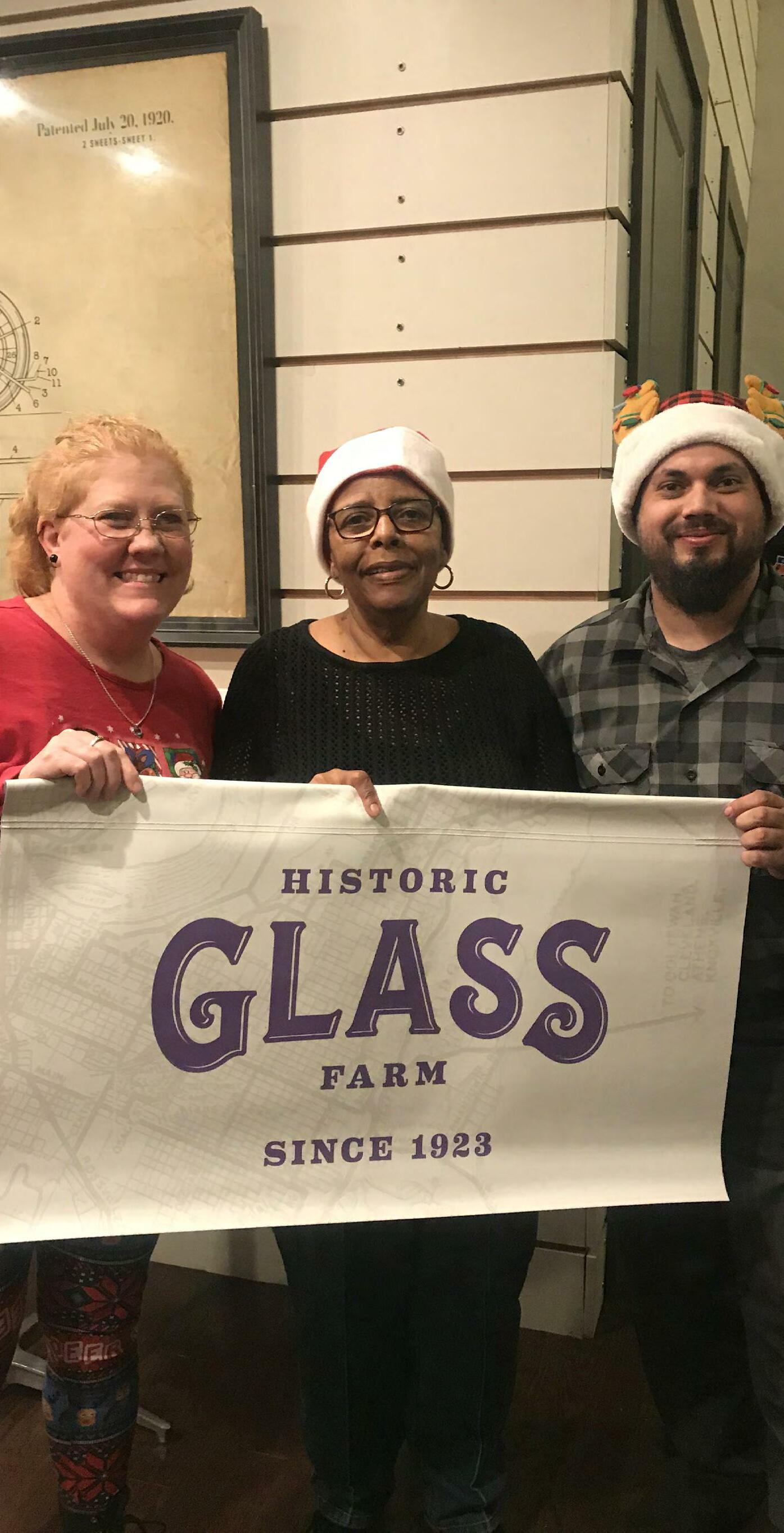

PROCESS = PRODUCT
We’d been told that as an arts organization, our final “product” had to be something concrete and lasting — a physical landmark in the community that symbolizes change. But we have learned that our process of engaging artists, making art, sharing art, and collecting around art is much more important to reflecting the culture and reinforcing the bonds of this neighborhood. The value of Glass Street LIVE isn’t just the party itself, it's the collaboration necessary to pull off that party: the connections made, the partnerships strengthened, and the creativity revealed by all of that community-building. BY
THE NUMBERS
learned
Street LIVE Block party events of local partners involved Attendees over the years Neighborhood Cleanups GSL events produced by resident-led committee Noteable, large, temporary & participatory art installations Glass Street brand co-created with community Pop-up Shops Bike repair station and rack Gospel on Glass events Highlight Festival activating a vacant HUD housing site Grant program funding artists & current Glass Street business owners Pop-up movie nights in partnership with green|spaces & LOVE fellowship Creative temporary installations Advisory Committee to choose 3 artist residences Sandwich board signs of local vendors showcased 100 s 8 of local artists involved 100 s 100 s 8000 40 2 5 1 15 1 6 1 1 20 75 1 15
Glass
OurPrinciplesGuiding
LIKE MANY ORGANIZATIONS, WE CAME TO OUR WORK WITH A TEXTBOOK OF BEST PRACTICES AND SAMPLE CASE
STUDIES PASSED DOWN TO US THROUGH OTHER PLACEMAKERS AND COMMUNITY ENGAGEMENT LEADERS.
But from day one, we’ve seen that instead of bringing (often flawed) conventional wisdom to this work, we needed to unlearn practices of the past and relearn the lessons of our community. In our decade working in Glass Farm, we’ve had our assumptions checked, our approaches questioned, and our beliefs reframed — and it’s always helped us do better. Here are just a few of Glass House Collective’s guiding principles, born out of those lessons that we’ve unlearned, re-examined, and dispensed with along the way.
RESOURCES COME IN MANY SHAPES AND SIZES
The needs of a community are as varied as the resources that will support those needs. Funds are fantastic, but so are people, partners, time, energy, and any number of other intangibles.
A BUNCH OF LITTLE THINGS
Creative, realistic, and scalable urban revitalization tactics have the power to push community change because they can be accomplished in timeframes that people can actually witness.
RETENTION > ATTRACTION
Any community can be added to, but real value comes from starting with what you already have right in your own backyard: neighbors, businesses, culture. Be who you are, first and foremost.
PRACTICE FAILING
It’s been said you need to document and replicate your successes, but we learned to document our failures too. In fact, our failures get learned from and embedded back into everything we do.
INVEST IN INDIVIDUALS
While a culture of volunteerism is important, residents shouldn’t be asked for their effort without investment in their time. We believe in paying neighborhood volunteers and project leaders.
PLAY = POWER
People are more likely to gather for a good time, so making placemaking a playful experience that neighbors want to participate in can unlock a wealth of community changing power.
PARTNERSHIP > A SINGLE ORGANIZATION
A single organization can’t responsibly take on all the work that may be needed in a community. There is enormous value in partnering with outside experts and complimentary organizations.
FEET ON THE STREET
When you can find meaningful ways to get people out of their homes and their cars and into shared transformational experiences, you can watch community-building happen in real time.
THE PLAN OF NO PLAN
Determining how something will end before it begins makes the process irrelevant. We believe that if you simply take one meaningful step after the next, you’ll know when you’ve arrived.
PLACE IS PRIORITY
What works on one block, in one neighborhood, and in one city, will not work the same way in another. Always begin your work by deeply understanding the place where you are working.
MAKE NO LITTLE PLANS
We believe in thinking “big” by thinking in little ways that resonate with the people that are living and moving in a space, working through what’s possible until the big plans can become real.
OUR PRIMARY MISSION IS PEOPLE
Staying reactionary is crucial to engaged work; we are serving the community, so we move as the community moves. The process of design isn’t static and final, it’s iterative and ongoing.
FOCUS ON FOLLOW-THROUGH
Formal planning and strategy sessions are important parts of the work, but doing what you say you will -- for a neighbor, for a business, for a partner -- is crucial to a community’s trust in you.
CAPACITY > CONTROL
At its core, placemaking is about building a community’s capacity to define its own sense of place through engagement and investment versus any top-down, organizationally-driven work.
FIGHT PERCEPTION WITH CREATIVITY
The best way to fight perception is to offer up an alternative. When people think they know a place and its people, creativity is the best tool you have in addressing that challenge head-on.
LISTENING > ACTION
Instead of seeing actions as the measure of our success, we invested in listening first. Having candid conversations with our neighbors has made all the difference in the success of the work.
THE VIRTUE OF PATIENCE
Placemaking doesn’t reap rewards without the benefits of time and reflection. We knew that as an experiment, our work would bear fruit once it had the time and resources to be fully nurtured.
TREAT THE ILLNESS, NOT THE SYMPTOMS
Remember that the change you seek lies within the context of decades of mistrust and systems of oppression. You can not succeed unless you intend to accept the actual challenge at hand.
ULTIMATELY WE FOUND THAT YOU’LL NEVER HAVE ALL THE ANSWERS IN COMMUNITY-BUILDING WORK. IN ADDITION TO UNLEARNING SOME LESSONS AND PICKING UP SOME GUIDING PRINCIPLES ALONG THE WAY, WE’VE ALSO ADDED COUNTLESS
ITEMS TO OUR LIST OF QUESTIONS.
How can community revitalization actively stave off gentrification? How does an organization balance creative excellence and community engagement? What is the responsibility of an organization when it comes to actively managing economic forces like real estate prices? How does an organization evolve when crises beyond the scope of their mission present themselves (like a global pandemic)? And perhaps most importantly, when is the right time to close this particular chapter of work in this particular community?
CREATIVE PLACEMAKING // 41
These are some of the questions we're still asking - and some of the lessons we're looking forward to learning as we look toward the future.
Collectiveimpact
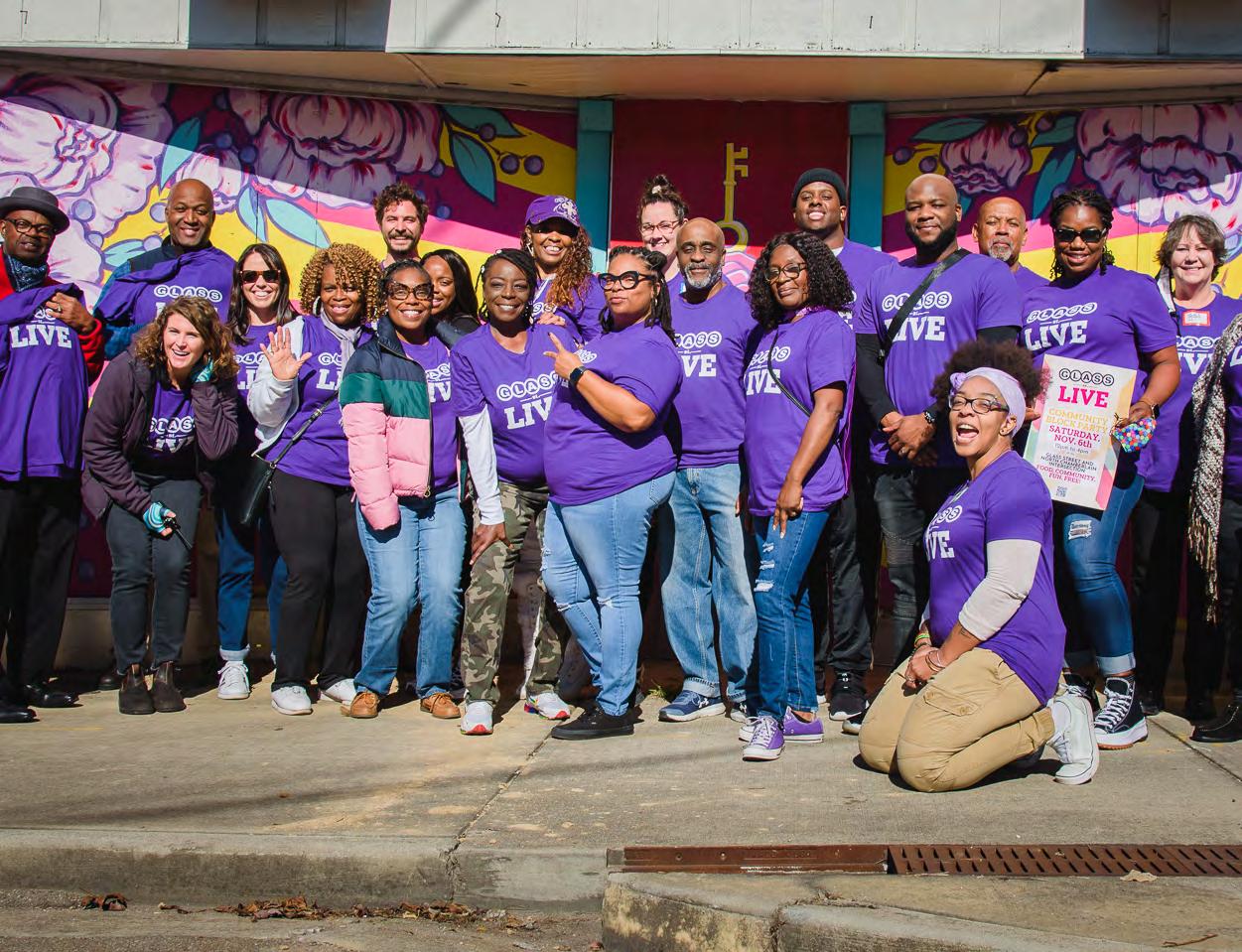
For more than a decade...
Glass House Collective coordinated change for this neighborhood, leveraging partnerships in service of a common vision, fueled by arts and culture embedded within the community and supported by resources gathered from near and far, with the intention to mutually reinforce the efforts of many and hold each other accountable to a shared investment in the best interests of this unique and united community.
COLLECTIVE IMPACT // 43
MeasuresSuccessStruggle of and
THE MEASUREMENTS OF SUCCESS ARE FUNDAMENTALLY DIFFERENT ON GLASS
STREET, IN NO SMALL PART THANKS TO THE COMMUNITY TAKING A STAND FROM THE EARLIEST DAYS ON WHAT CHANGE THEY WANTED…AND WHAT THEY DIDN’T.
Looking back, the body of work of this collective is as important for the things that didn’t happen, as it is for those things that did. Capacity, connections, and relationships are not your typical redevelopment stories, but they are what drive a community. Too often, the data points used to quantify the success of urban revitalization rely on the kind of changes that can do harm to the community itself.
Glass House Collective was built on the foundational belief that this once-thriving urban community is not only worth supporting, but that the resources to engineer its revival were already within its grasp. That sense of empowerment, determination, and hope goes far beyond the metrics of economics or real estate development or social infrastructure. It demonstrates the agency that a community can embody, when it creates a vision for its own future. With the support of a collective with a mission to catalyze rather than control, that future can come to life.
Creative placemaking has produced sustainable, permanent changes in the business, residential, and public environments of the Glass Farm neighborhood, resulting in increased investment in private and public spaces.
THE FOLLOWING IS A SUMMARY OF THE MEASUREMENTS OF COLLECTIVE IMPACT THAT REPRESENTS THIS BODY OF WORK.

COLLECTIVE IMPACT // 45
NEEDS & CHALLENGES
Data
Consistent themes emerged from our earliest conversations with neighbors - their hopes for a cleaner, safer, and more inviting neighborhood. We heard about the importance of having access to goods and services within the neighborhood. We learned that the needs of the community were varied and often interrelated.
These conversations also surfaced the immense economic, social, and infrastructural challenges the neighborhood faced. The obstacles to safety and development were many:
• Vacant and underutilized properties
• Abandoned buildings
• A deficit of public investments in streets, shared spaces, and amenities
Community 2016 2019
These obstacles made it difficult to realize the cleaner, safer, and more inviting neighborhood that residents wanted. Similarly, these barriers reduced the likelihood of new commercial tenants that could provide access to goods and services moving into the neighborhood.
We saw similar themes emerge from a 2016 Habitat for Humanity survey 1 of Glass Farm resident opinions and experiences, confirming the most pressing community needs, but also informing us that Glass House Collective’s work in the community was far from complete.
1 To begin its neighborhood partnership, Habitat for Humanity of Greater Chattanooga conducted a face-toface, door-to-door survey of 149 Glass Farm residents between September - November 2016. The survey was conducted through “Porch Sitting” sessions, in which each resident or family participated in a 20 to 60-minute conversation. A survey of 89 residents was conducted again in 2019 to measure changes in resident opinions and experiences. Habitat for Humanity Comparison Survey: Key Findings (2016 and 2019)
HABITAT FOR HUMANITY SURVEY RESULTS
of residents indicated that traffic or speeding vehicles were a problem in the neighborhood of residents named litter, trash, or debris as a problem of residents named poorly maintained streets and sidewalks as a problem of residents named abandoned or vacant non-residential buildings as a problem of residents named safety as one of three things they liked least about living in the neighborhood
HABITAT FOR HUMANITY SURVEY RESULTS
increase in levels of neighborhood satisfaction in 3 years
decrease in levels of neighborhood dissatisfaction in 3 years
increase in adequate basic retail necessities in 3 years
decrease in feeling of nighttime pedestrian safety in 3 years
of overall respondents demonstrate feeling part of the neighborhood
60 % 15 % 58
15 % 52
10 % 49 % 43 % 26
49 %
%
%
%
BY 2019, WE COULD OBSERVE STATISTICAL SHIFTS THAT HAVE OCCURRED IN THE GLASS FARM
AREA, PROVIDING US WITH KEY INDICATORS OF REVITALIZATION OVER THE COURSE OF GHC’S WORK.
The following table compares 2012 and 2019 American Community Survey estimates (5-year) for zip code 37406, which includes the Glass Farm, Boyce Station, and Avondale neighborhoods in addition to other East Chattanooga communities. It is significant that, while the majority of the demographic data points of the neighborhood remained fairly consistent between 2012 and 2019, two critical categories indicating community well-being – the unemployment rate and the poverty rate – saw sharp decline.
37406 ZIP CODE INCLUDES GLASS FARM, BOYCE STATION, AVONDALE, & ADDITIONAL EAST CHATTANOOGA COMMUNITIES
Category
Total Population Black or African American
White Other Race
Two or More Races
Hispanic or Latino
Population Age 25 & Above
Educational Attainment High School Graduate or Higher (Age 25 and Above)
Educational Attainment Bachelor’s Degree or Higher (Age 25 and Above)
Population Age 65 & Over
Housing Units, Owner-Occupied Unemployment Rate
Poverty Rate
2012 - ACS 5 Year 14,450 78% 18.5% 1.1% 2.5% 1.9% 9,056 72.8% 7.2% 15% 47.4% 22.9% 35.5%
2019 - ACS 5 Year
14,058 76% 20.5% 0.5% 2.5% 0.4% 9,980 78.8% 11.7% 19% 45% 12.3% 29%
plans together
A Community stands together. that "
It seems like our time together was spent picking up the big and small pieces of broken glass. Even in those broken pieces, I could see a reflection but the reflection is so much brighter now. The process was the art. That art was the beauty of this entire process that resulted in people working collectively to put something back together again. "
McClure
Audrey
RESIDENT
- GLASS FARM

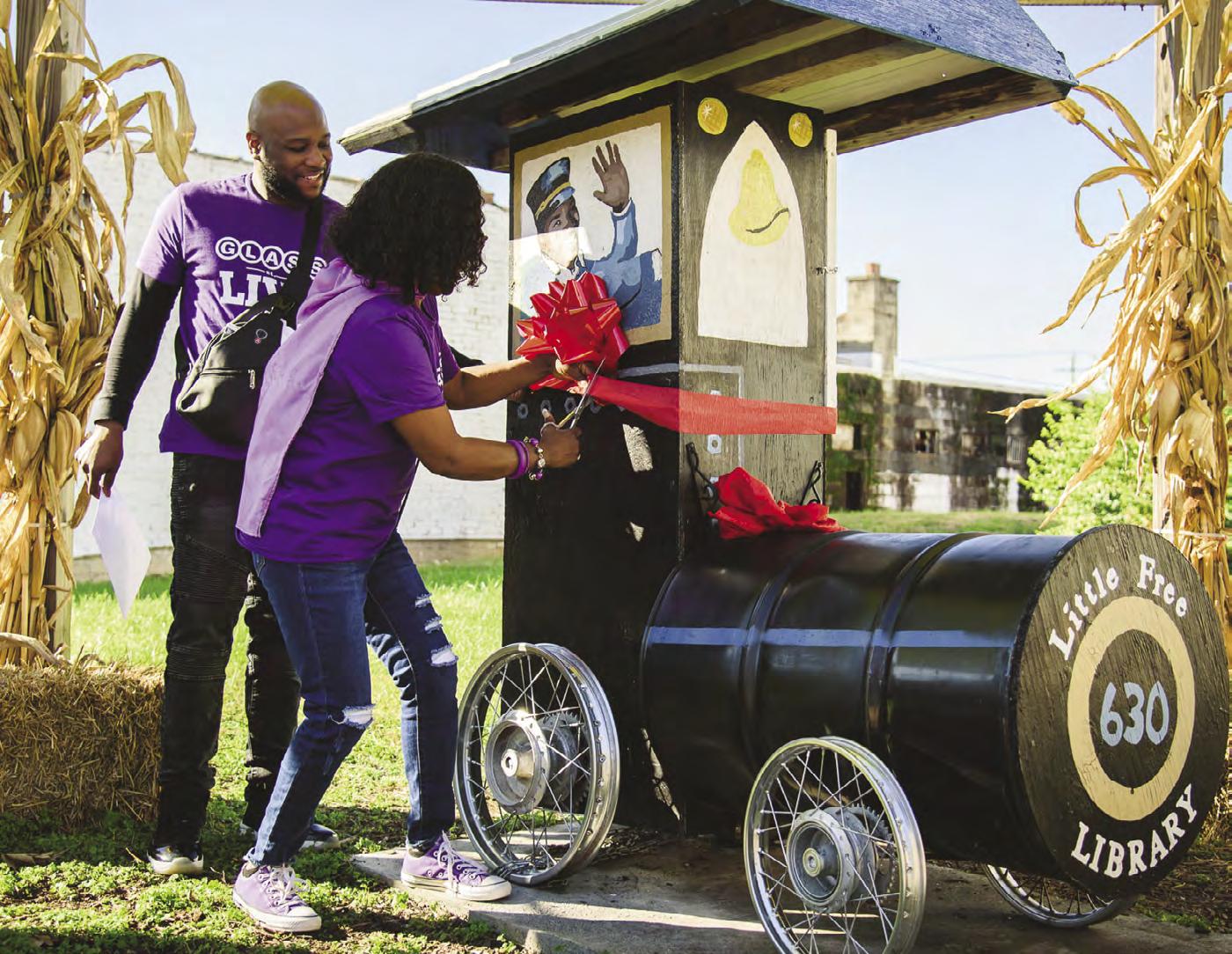

COLLECTIVE IMPACT // 49
on InvestmentGlassStreet
AND IN THE GLASS FARM NEIGHBORHOOD
From the start, Glass House Collective knew that empty storefronts were a symbol of decline, so we incorporated the importance of putting feet on the street into our work. The results have been impressive: today on Glass Street, you can meet a friend for coffee, buy a book, visit a salon, do your grocery shopping, and more. The investment outcomes were a team effort:
• •
Funders provided $683,257 in business development funds including signage, permanent murals, façade restoration grants, pop-up business initiatives, renovation of two completely vacant buildings, etc;

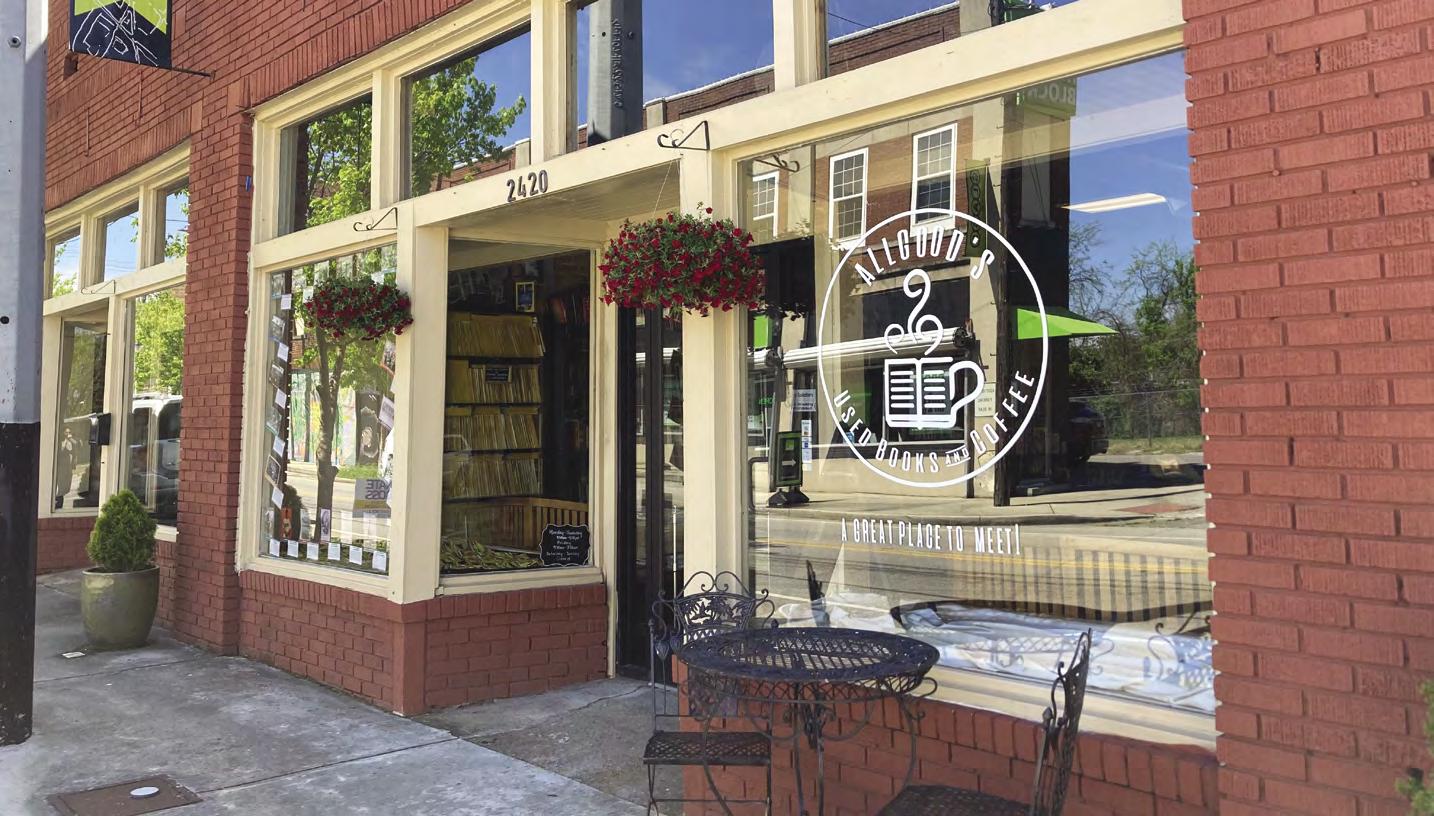

In turn, businesses have made $2.2 million in purchases and renovations to buildings;
•
As a result, commercial occupancy on Glass Street is up 32% over the past decade.
Case in Point...
STUDIO EVERYTHING
The building owner of this space use to use the building to store his large drive his large construction vehicles. Through a matching facade grant and technical assistance, GHC partnered with the building owner to bring the building back to life for an artist to occupy the space for a year-long residency. The artist continued to lease the building on their own after the residency and was present in the community for years after.
ALLGOOD'S USED BOOKS AND COFFEE
Allgood’s Used Books and Coffee has a long history dating long before Glass House Collective was founded. Miss Betty owned buildings and businesses in Glass Farm a few decades ago and her family are long-time East Chattanoogans.
Over the past few years, Miss Betty decided to re-invest in Glass Street and we could not be more excited! Her three formerly vacant storefronts are now neighborhood destinations and home to the first Black-owned coffee and book store in Chattanooga. This investment was completely done by Miss Betty and her family without any assistance from Glass House Collective. This is a great example of resident-led development.
"I could see the area begin to improve. I could feel the energy and see everyone coming together during the block parties. I knew the neighborhood was moving in the right direction and that it was going to take time. I’m glad I invested in this community with my business and look forward to continuing building improvements.
H&R BLOCK
H&R Block used to be known as “Rapid Tax,” inside one-storefront with a leaking roof, dark lighting, and one employee. Owner Joe Lautigar saw the changes happening and was encouraged with recent investments in public infrastructure, neighbors spending more time on the streets, and the block parties. Because of this momentum, he invested and renovated the entire first floor of his building and became a franchise with H&R Block. We now have multiple storefronts renovated, updated signage, long windows, multiple employees, multiple murals commissioned by the owner, and a solid business to support.
Joe Lautigar - BUSINESS OWNER ON GLASS STREET
You just have to have a little bit of faith and stick to it.
"
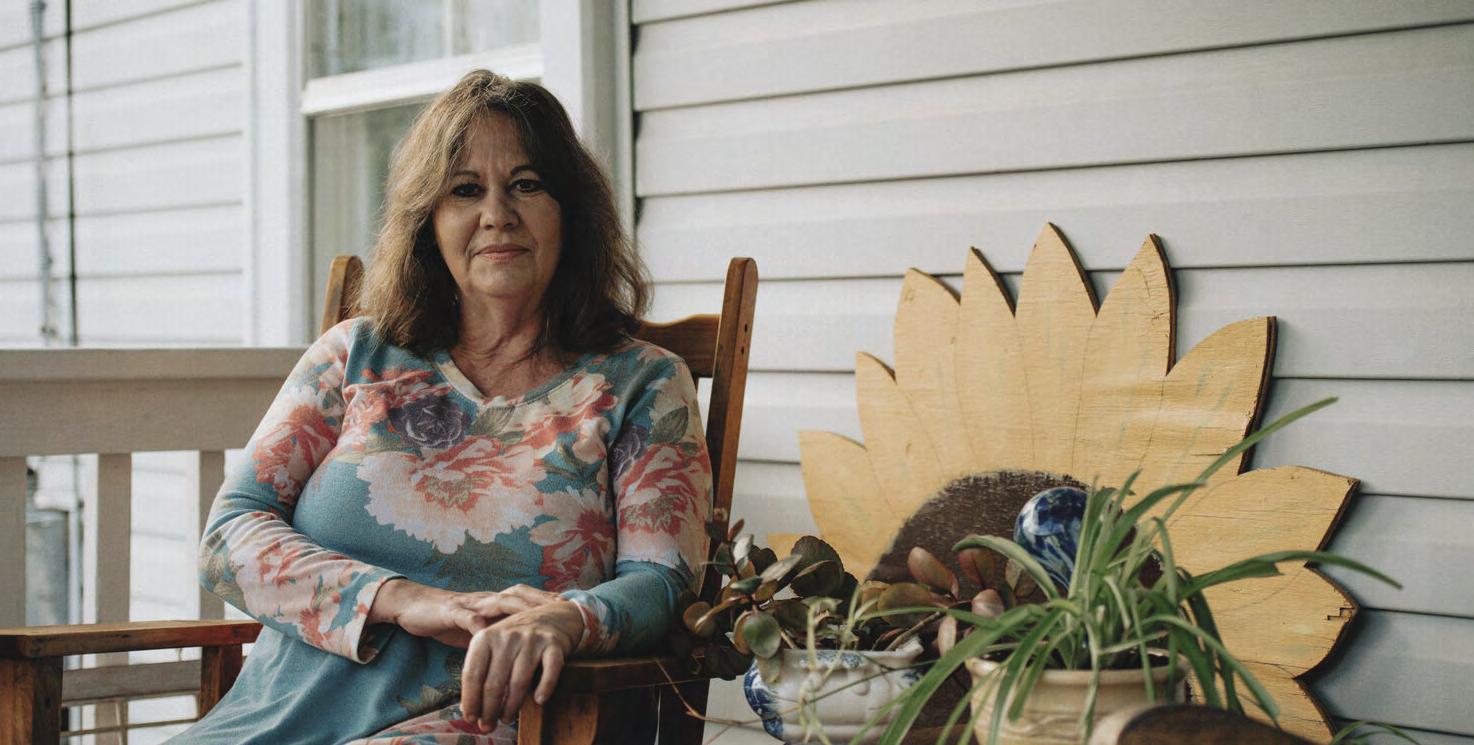

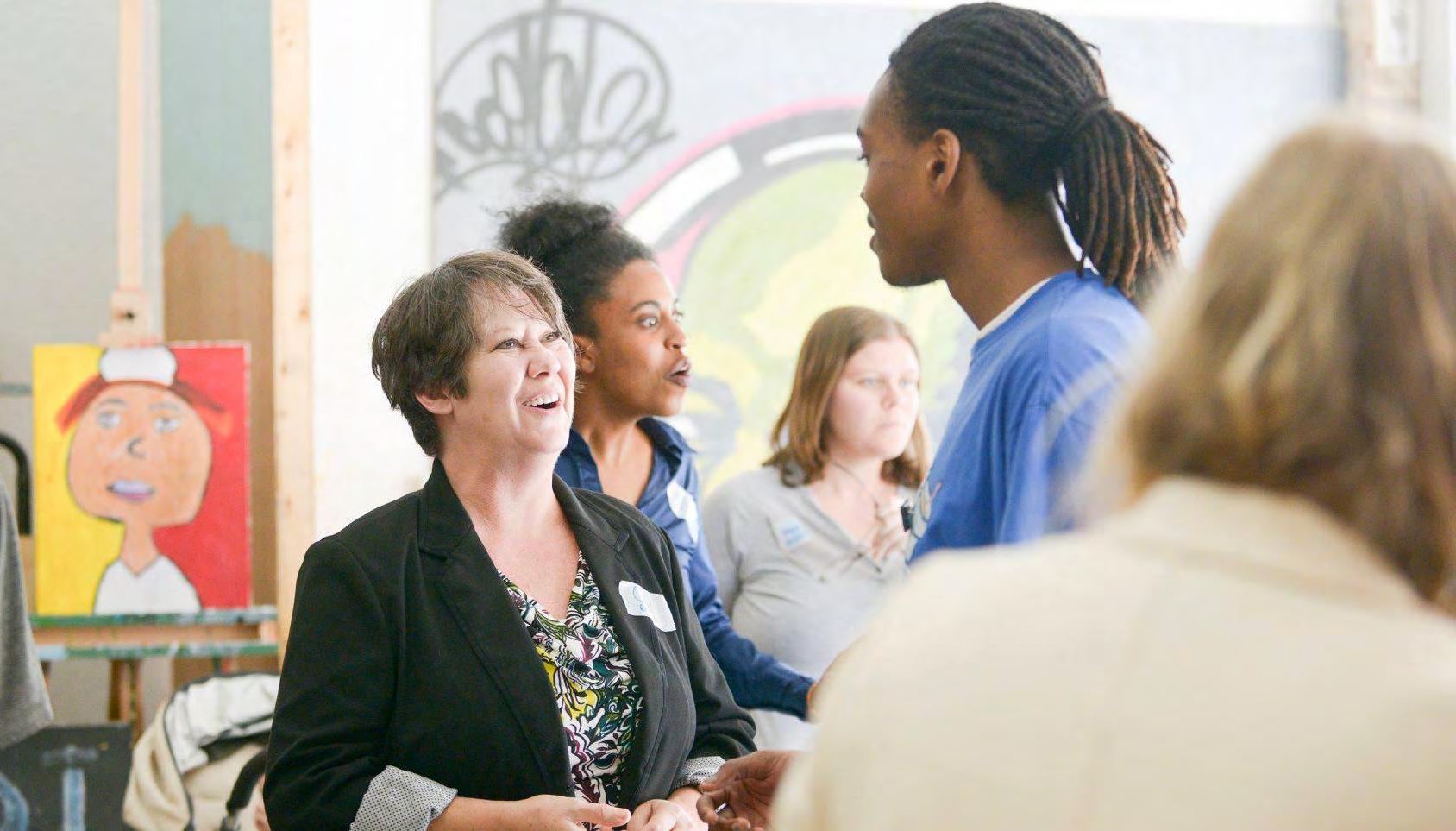
Good things happen when we're eye to eye, face to face, and able to absorb the passion many of us have for our neighborhood Gail
McKeel - GLASS FARM RESIDENT " "
ON A SIGNIFICANT COMMUNITY NEED
a Shining Light
The empty 18,000 square foot, former grocery store near the corner of Dodson and Glass was both an eyesore and a barrier to accessing fresh food in the neighborhood. Yet after years of dedication, the now-renovated and reopened Save-A-Lot grocery store is a crucial and long-awaited addition to Glass Farm. Our process to spur its redevelopment was straight-forward: do what we can with what we have. That included building awareness around the nutritional inequality that our food desert reinforced 2 and focusing on improving the public realm adjacent to the property as a neighborhood gateway. Once we knew a grocery was coming to the location, we continued public space improvements with community-centered design, installing a mural and creating Love Park in order to continue activation of the location. It took 7+ years of constant attention and community support, but the community is better for it.
2 Diet And Perceptions Change With Supermarket Introduction In A Food Desert, But Not Because Of Supermarket Use Tamara Dubowitz, Madhumita Ghosh-Dastidar, Deborah A. Cohen, Robin Beckman, Elizabeth D. Steiner, Gerald P. Hunter, Karen R. Flórez, Christina Huang, Christine A. Vaughan, Jennifer C. Sloan, Shannon N. Zenk, Steven Cummins, and Rebecca L. Collins Health Affairs 2015 34:11, 1858-1868.
ERADICATING A FOOD DESERT, YEAR BY YEAR:
2014 - Closure of Sunnytown former grocery store at Dodson and Glass
2015 - Workshop focused on setting new vision for the key intersection
2016 - How-To Guide created and strategic plan put in place
2017 - Glass Street LIVE annual street party moved to the intersection to highlight the importance of this gateway and to kickoff planning engagement
2018 - Streetscape plans developed with the neighborhood, and delivered to City and State transportation agencies to spur needed improvements
2019 - City granted $30K to improve the site to attract development
2020 - Workshop focused on creative projects at key intersection improving safewalks for youth, public space opportunities, and increased connectivity between the SaveA-Lot, Recreation Center, and elementary school
2021 - Grand opening of Sav-A-Lot, installation of Love Park in conjunction with the installation of the asphalt mural, Save-A-Lot mural installed, and Lunch @ Love music series launched
• • • • • • • •



"
It has been an honor
to be able to bring to my community the spirit of love
I have learned that if you show respect then they'll give respect which uplifts our community. That uplifting adds dignity and integrity to our place but more importantly our people.
I have shared this spirit of love while performing on stage with my gospel band during Gospel on Glass events, in community organizing classes through SWAY, door knocking to recruit homeowners for home improvements with Habitat, assisting my neighbors with exterior home improvement projects through ‘Neighbor Labor’ events, participating in planning workshops, collecting surveys, working with students and youth, helping create the name, theme, and design of our new LOVE Street Park, and over the past year or so serving as a team member of GHC. I am so thankful for all of these experiences and the spirit of love that continues.
Deborah Bledsoe
- GLASS FARM RESIDENT
"
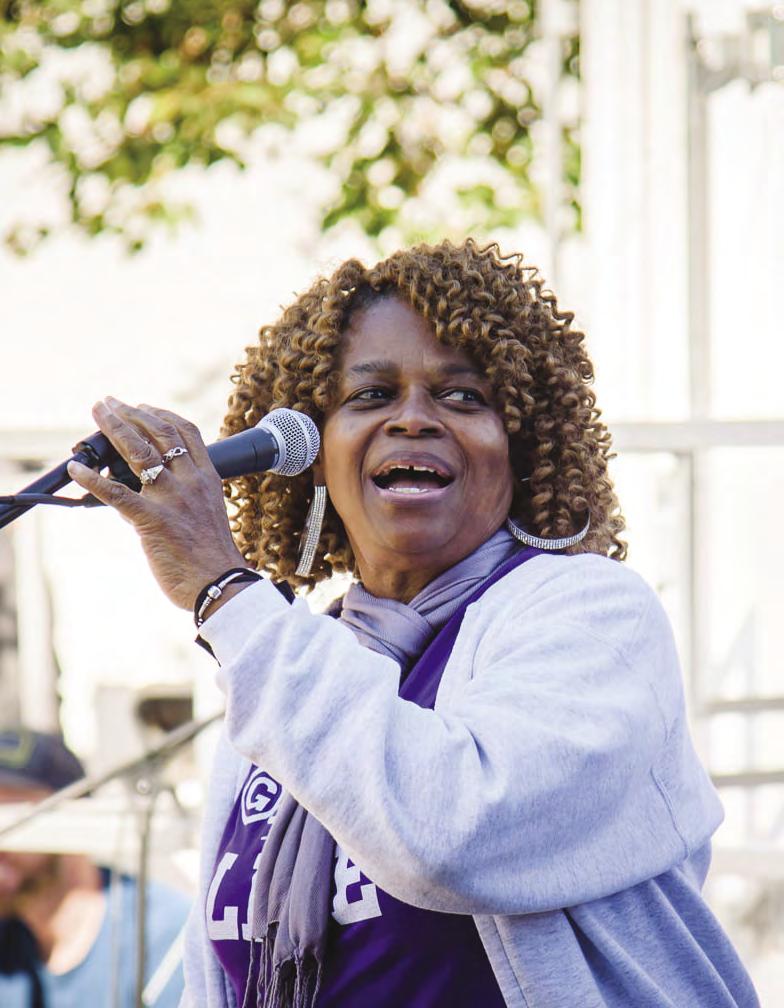
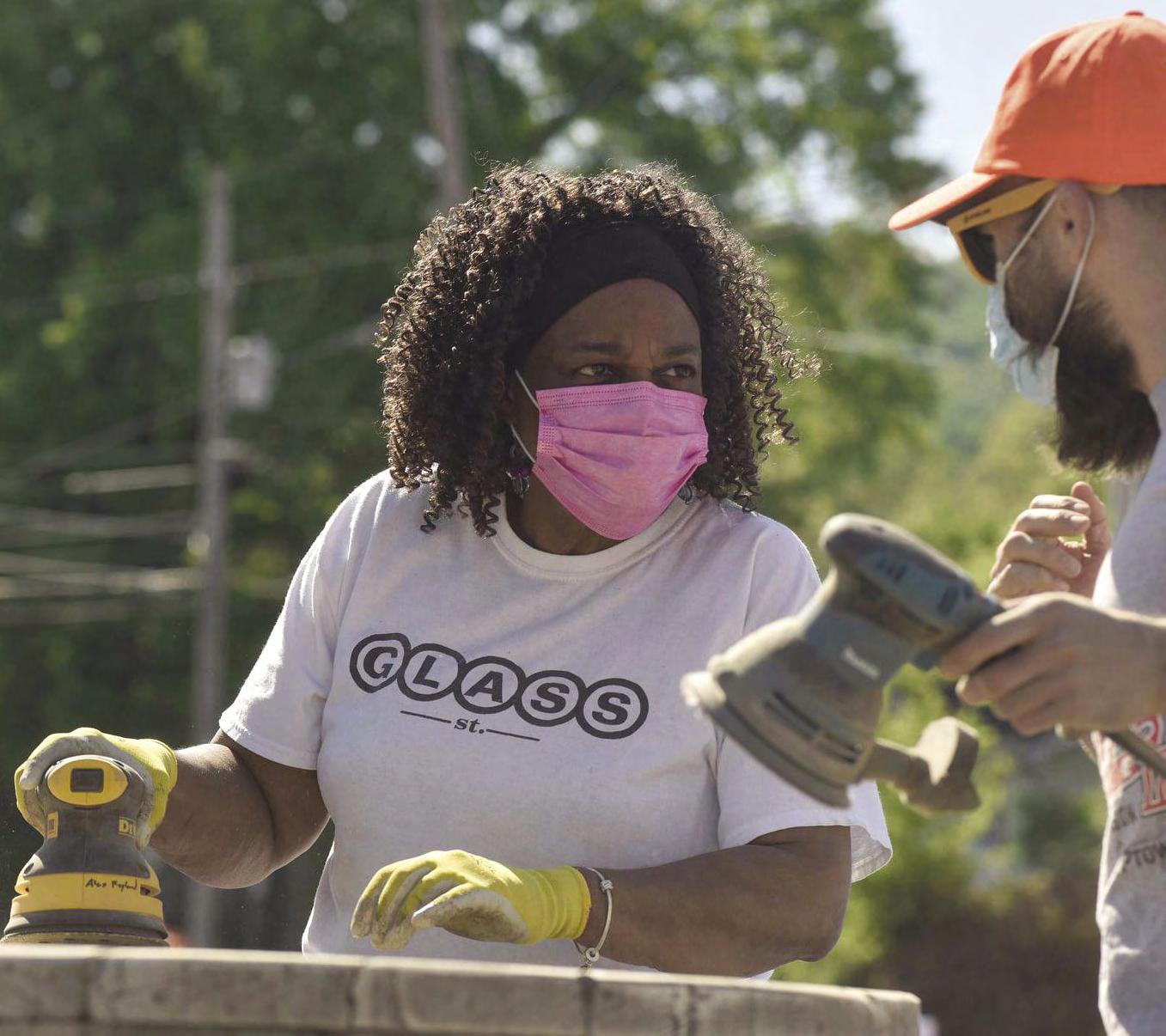

COLLECTIVE IMPACT // 57
it
Making Safer
TO PUT FEET ON THE STREET
Making Glass Street safer and more inviting through a variety of streetscape investments was a process that took many years but produced impressive results. Whether they were neighbor-sourced or City-funded, the addition of street trees in the Glass Farm neighborhood signaled meaningful investment in the community, and worked to correct this local example of what is a national pattern of urban tree canopy inequity 3. Additional improvements to the streets and streetscape were just as important:
•
Three new bus shelters provide protection for riders waiting for their transportation;
•
Six new artistic seating options provide a welcoming atmosphere for the elderly and school-aged children waiting on school buses;
•
Pedestrian lights and neighborhood sidewalks signal: this is a place to stop and explore, not just drive past on your way to somewhere else;
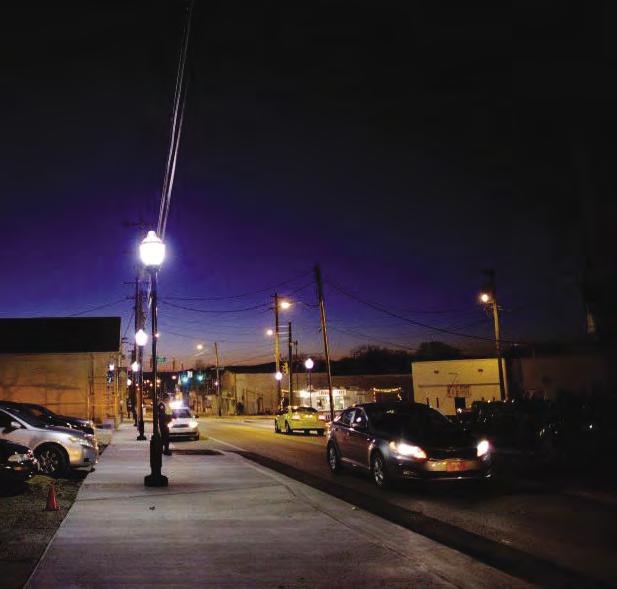
And while colorful painted crosswalks bring vitality to wide expanses of pavement, they also make intersections safer, calming traffic and drawing driver attention to pedestrians. 3 https://www.scientificamerican.com/article/trees-are-missing-in-low-income-neighborhoods/
•

Janette Richie
in our community when our
I believe things can continue to improve when more people in our community can come together
We have seen good things neighbors choose to get involved. " "
- GLASS FARM RESIDENT
relationship by relationship Community is built "
Seeing this type of connection grow, enriching the community through art and public action, has been immensely rewarding.
I’m most grateful for the opportunity to work with so many passionate and gracious leaders through Glass House Collective and the SWAY workshops, people who are committed to working together in creative projects to build power for change. Their success is a benefit to all of us who call Chattanooga home.
Michael Gilliland
- PARTNER
"

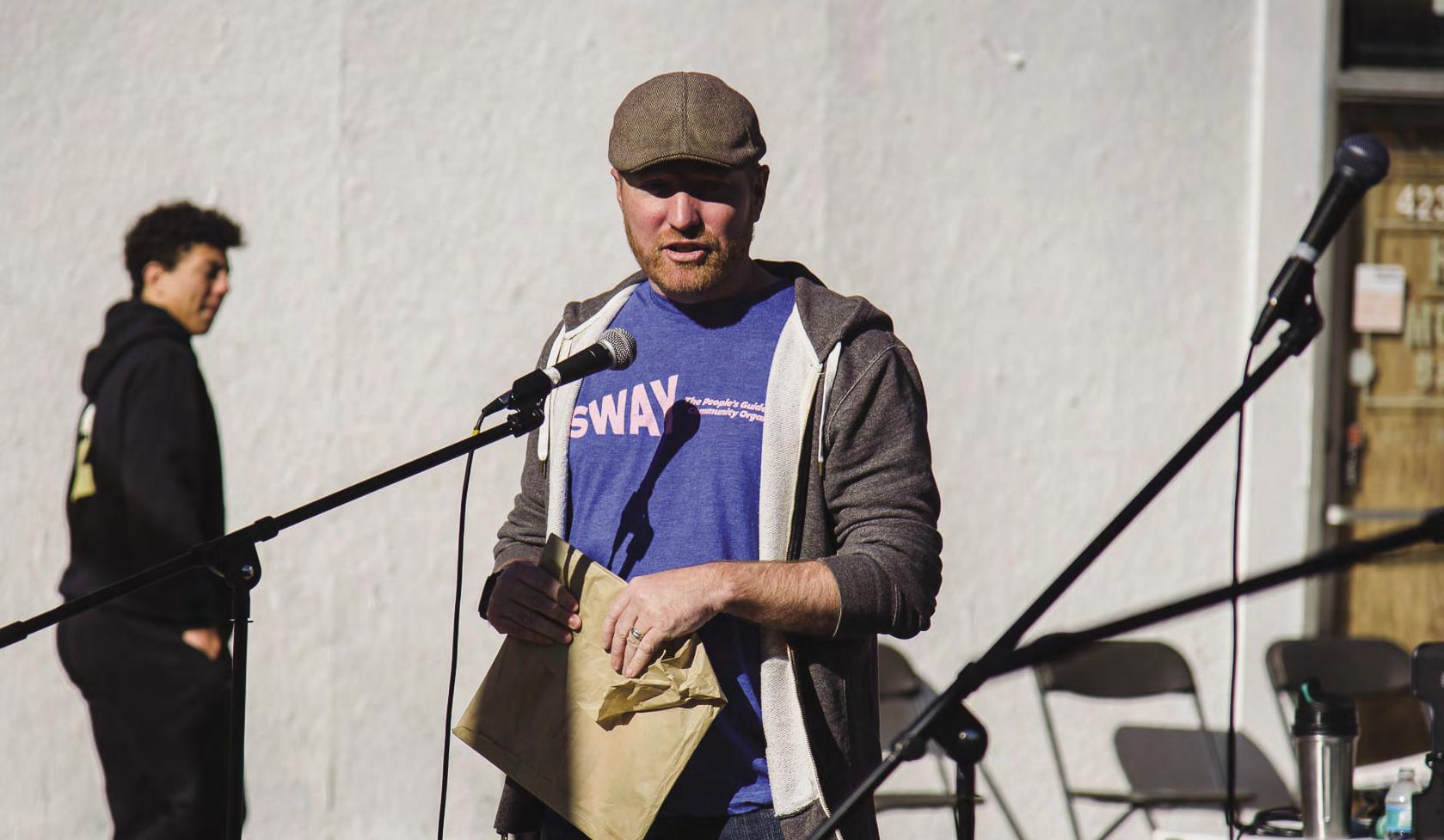

COLLECTIVE IMPACT // 61
the Supporting Network
OF NEIGHBORS WHERE THEY LIVE
Housing in Glass Farm was something that neighbors were focused on improving from the start. Importantly, the improvement that has happened over the past 10+ years has been manageable, so that neighbors have remained in their homes and displacement has been avoided:

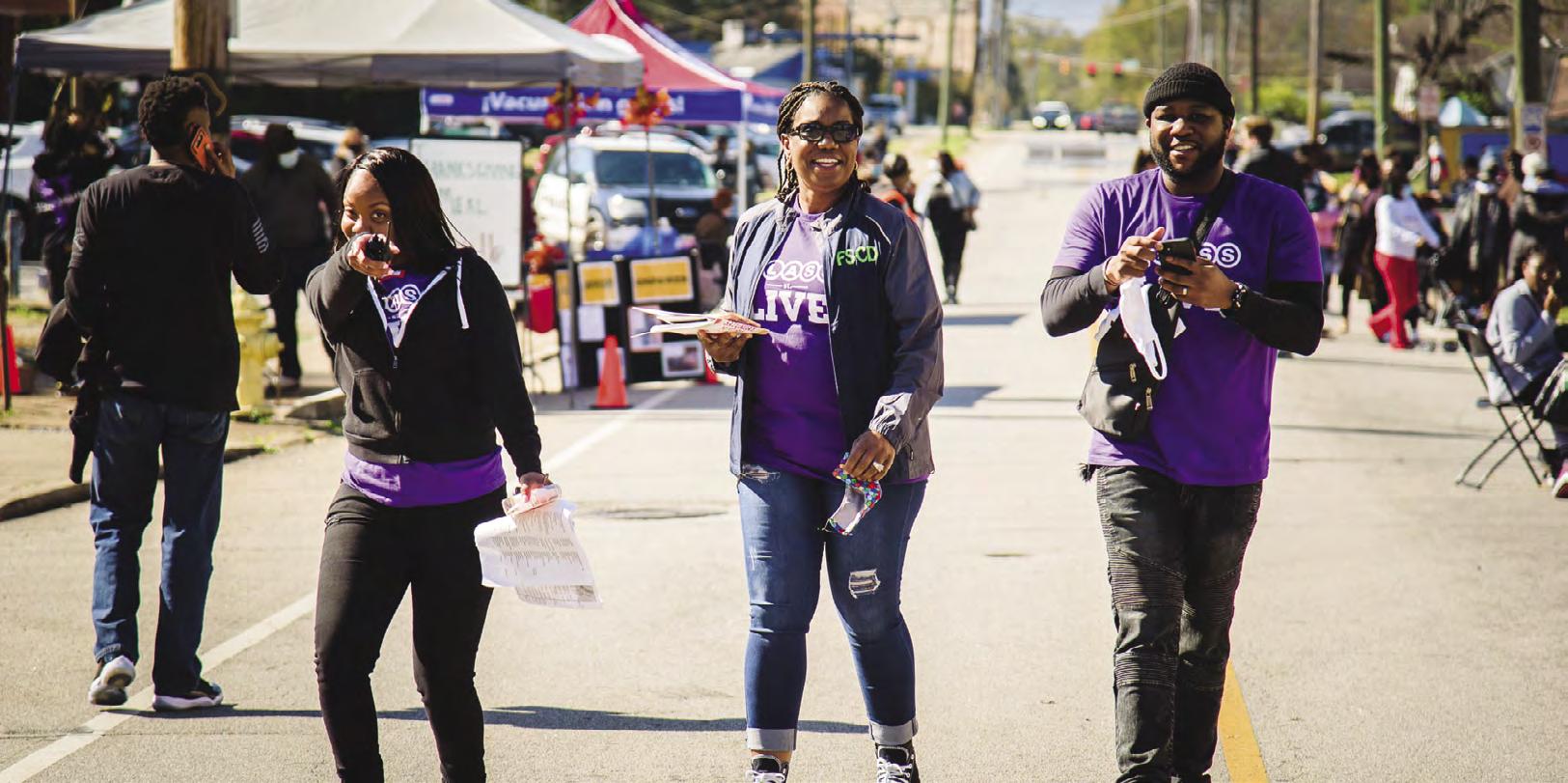

•
Median home value has only risen 8.5%, while both the low and high ends of home value have shifted substantially (roughly 320% and 75%, respectively), indicating home value stabilization and reflecting a gentle residential revitalization;
•
Reporting of blighted properties increased with the help of our community education (reports more than doubled from 2012 to 2016/17) and have since declined as the needs are addressed by the City (steady annual decline from 2018 on).
Removing the most uninhabitable homes has helped our neighbors by dislodging previous perceptions that may have held back property values within the community. Taken along with streetscape and facade improvements, lower vacancy rates, neighborhood cleanup efforts, and the Glass Farm neighborhood signage initiative, our observation suggests a paced economic development. We have witnessed first-hand the way that bringing pride back to the community through physical investments can mean so much to the people who see them every day.
...I have witnessed a
substantial tangible spark decided involvement of of legitimate change to our area due to the direct and Glass House
Collective...
Knowledge of ‘aim high’ and ‘let reality create a lasting tangible result’ was the authentic understanding, and results did manifest! New levels of heightened safety, cleanliness, and business activation indeed became seeded and have taken root. "
"
Fred Flach
- BOYCE STATION / EAST CHATTANOOGA RESIDENT
We didn't really know what we were doing, but we all were in the habit of doing.... which allowed us to learn so much. I became a better human through the open opportunity to start my poetry workshops on Glass Street. "
Genesis the Greykid
"I loved how open Glass House Collective was to artists that wanted to pour into the community through art, through poetry, through love.
- ARTIST / POET



COLLECTIVE IMPACT // 65
COMMUNITY-INVOLVED IMPROVEMENT
Artist-Led AND
The importance of play shouldn’t be forgotten, and the creation and activation of multiple open spaces has given our neighbors many ways to enjoy connecting with their community.
• • •
Pop-up parklets have become permanent at the intersection of Chamberlain and Glass;
Large scale murals and colorful street signage throughout Glass Street signaled gathering spots, sending the message that Glass Farm is a neighborhood that can be enjoyed;
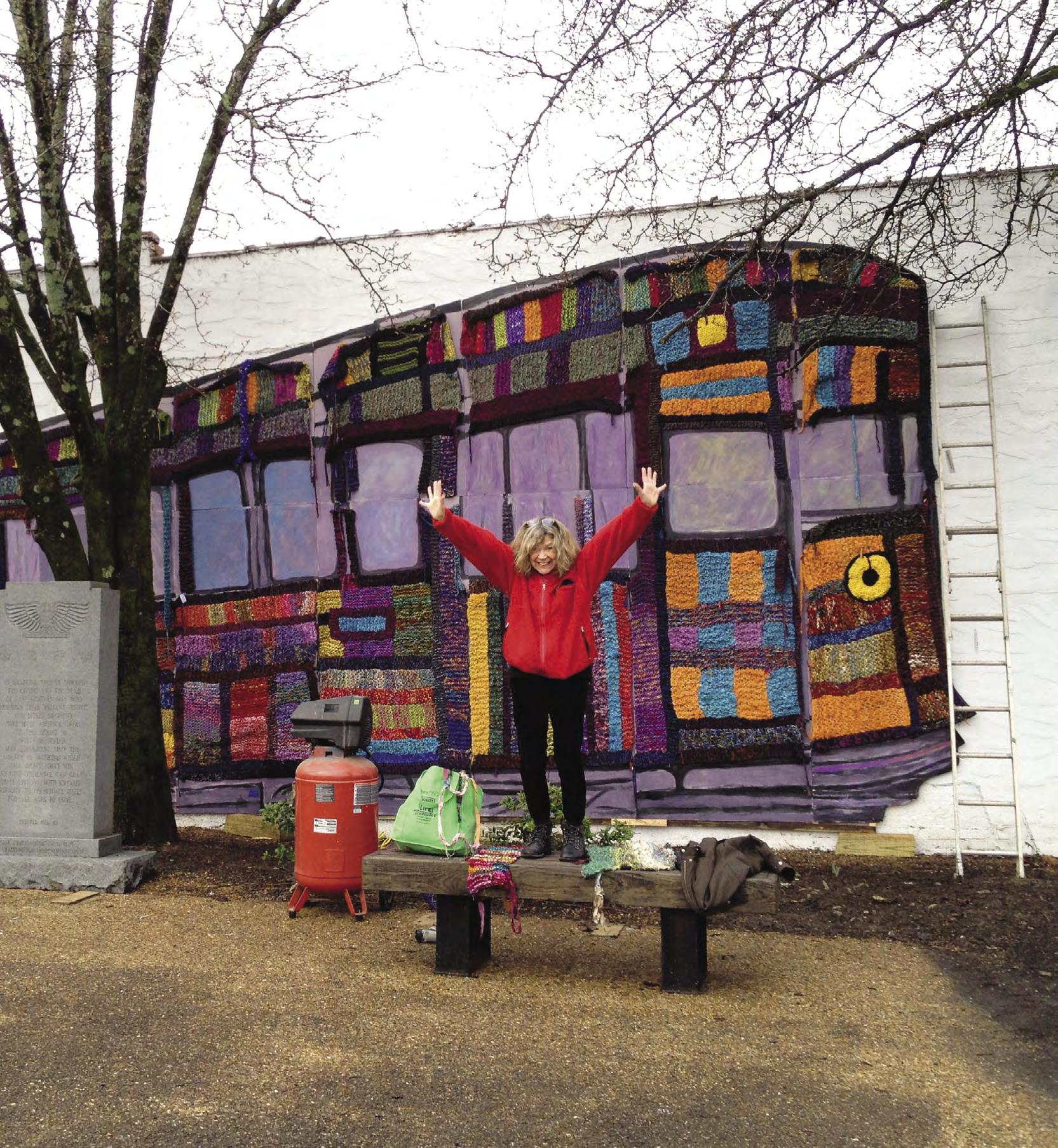

Bringing artists to this work through all types of temporary and permanent installations brought an undeniable sense of shared investment in this community;
•
And we raised $2.85 million in local and national funding, $1 million of which went directly into the hands of local artists making a local impact.
Glass House Collective was able to use art and creatives as a mechanism for bringing investment into the Glass Farm neighborhood.
"People who would wave at you when you walked by, who smiled when they saw you, who were interested in what you were doing. People who told you their stories, their dreams, their sorrows, and people who proudly showed their accomplishments. It made me feel that I was part of them, it was a clear feeling of belonging.
Being involved in this process
Olga De Klein
from the beginning has enriched my life.
"- ARTIST
Shared Investment in the future of the community
OVER THE COURSE OF 10 YEARS
IN THE NEIGHBORHOOD, GLASS HOUSE COLLECTIVE WAS A PART OF A MOVEMENT TO ENVISION A STRONGER FUTURE
From supporting the re-awakening of what had become a street of vacant storefronts, to making a long-term commitment to eradicating the local food desert, to bringing attention and providing action to ensure safety and security on the streets of Glass Farm, to meeting residents where they were with help for their most immediate needs, to centering the arts and artists in bringing life to the hopes that the community holds for itself, the collective impact of this body of work is complex and its achievements are often complicated. It is impossible to quantify the lived experiences of the people who contributed to this collective, but it is their reflections on the work that best exemplify the measurements of success for Glass House Collective.
Community work is contextual, and it is not always simple, easy, or quick. It is not built on metrics; it is secured one relationship at a time with conversations that lead to connections that lead to a tapestry of trust. Physical improvements and visible change can be seen throughout the neighborhood, but the true legacy of the past decade will be the ongoing commitment that the community continues to make to itself and its future as a collective.
MAKING
AND TAKE MEANINGFUL STEPS TOWARD
THAT VISION A REALITY.
WE THINK GLASS FARM RESIDENT GAIL MCKEEL SAID IT BEST, WHEN SHE ANSWERED THE QUESTION OF: WHAT IS THIS WORK? “UNCOMMON PARTNERSHIPS. SERENDIPITOUS COLLISIONS. DIVERSE CONNECTIONS.”



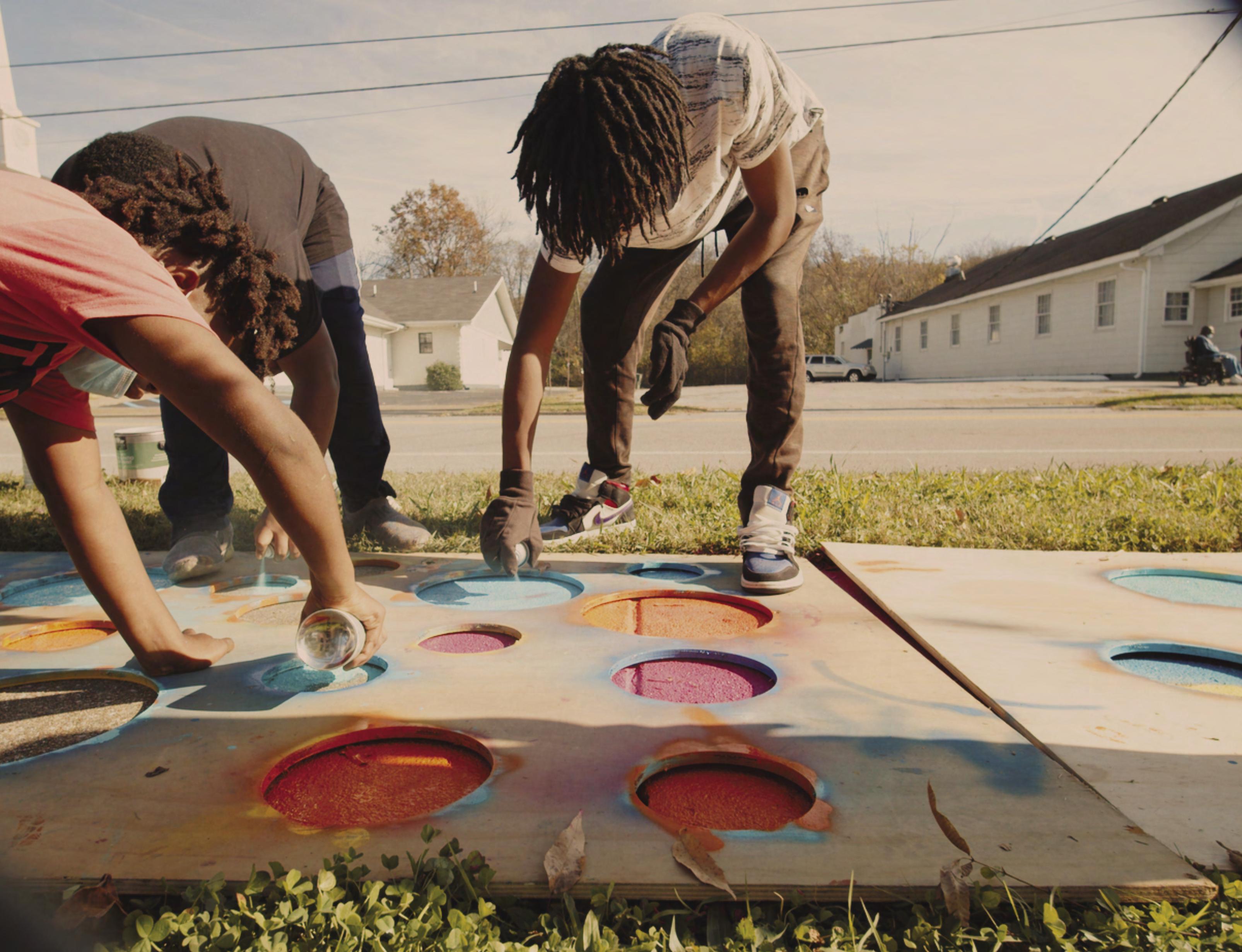
For nearly a decade...
...Glass House Collective has worked with the Glass Farm community. Here are a few highlights from our shared story -- the events that brought us and our neighbors together.
FROM LEGWORK TO BLOCK PARTIES
Hosted a listening tour and attended neighborhood association meetings
Secured, renovated, and set up a physical HQ to demonstrate our commitment to the area
Brought LAUNCH, a small business planning class, to the area to increase entrepreneurship
Hosted an AIA Conference on Glass Street to identify local projects
Translated conference findings into short-and long-term projects
Published our first How-To Guide to put projects in front of the public
Brought project plans to community meetings for feedback and input, resulting in our first streetscape plan
Invested in residents and artists to complete shortterm projects
Hosted our first block party, Glass Street LIVE
FROM POP-UPS TO PERMANENCE
Hosted an all-hands-on-deck Better Block party with temporary installations to bring the future to life, including:
Rise Up: A ladder sculpture in the heart of Glass Farm symbolizing a community rising up together

Flea Market: A resident-led pop-up market that lasted for over seven months
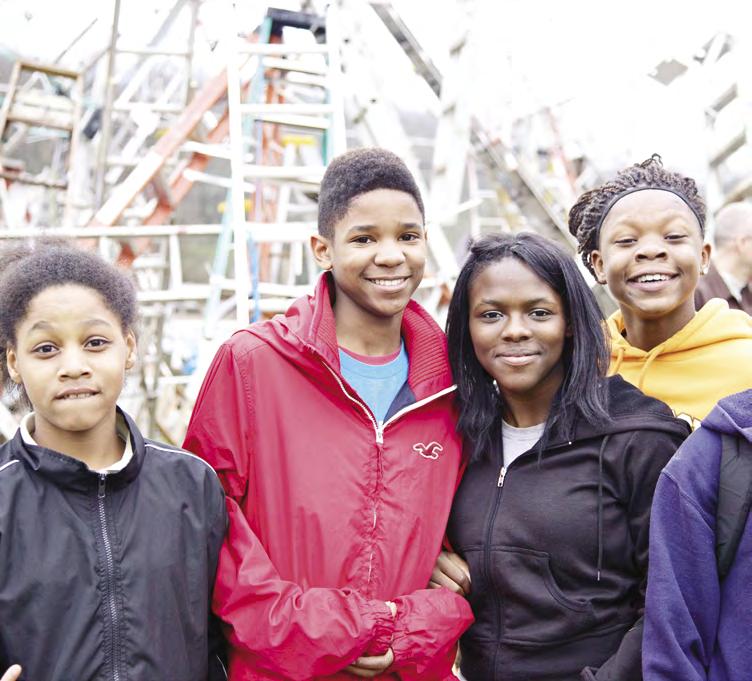

Bank Arts Collective: An African American Pop-up Art Museum bringing art to Glass Farm
Collaborative Mural: A Glass Street community project
Temporary Streetscaping: Temporary crosswalks, bike lanes, and seating to test out the permanent plan

Façade Improvements: Launched a façade improvement grant for Glass Street property owners
Creative Seating: Installed artist-designed seating along Glass Street
Hosted ongoing community meetings to get feedback on streetscape plan
Partnered with the City to implement our community plan at Glass Street and North Chamberlain Avenue, including:
Streetlights and streetscaping
New sidewalks and crosswalks
Benches and bus shelters
Brought neighbors together to form the resident-led group, Good Neighbor Network
FROM ARTS FUNDING TO ARTS ACTIVATION
Launched artist residencies to help activate public spaces and set up studios, including:
Supporting artist Rondell Crier’s woodworking space
2014
2012
2013
• • • • • • • • • • •
• •
Opening GHC space to Rebekah Mawuko’s dance studio
Supporting the creation of graffiti alley, a spoken word series led by Genesis the Greykid and urban art classes by The Artist SEVEN
Developed Glass Street Park , a space built by local architects and volunteers
Co-hosted first Gospel on Glass event, which became a recurring event
Launched a pop-up skate park
2015FROM RETHINK TO NEXT BIG THING
Paused to rethink, rebuild, and raise new funding Hosted Next Big Thing conference to identify new priorities
Refocused priorities to include Public Space & Streetscape; Business Development; Residential Published second How-To Guide with new strategies laid out Recruited artists to activate short-term projects from workshop
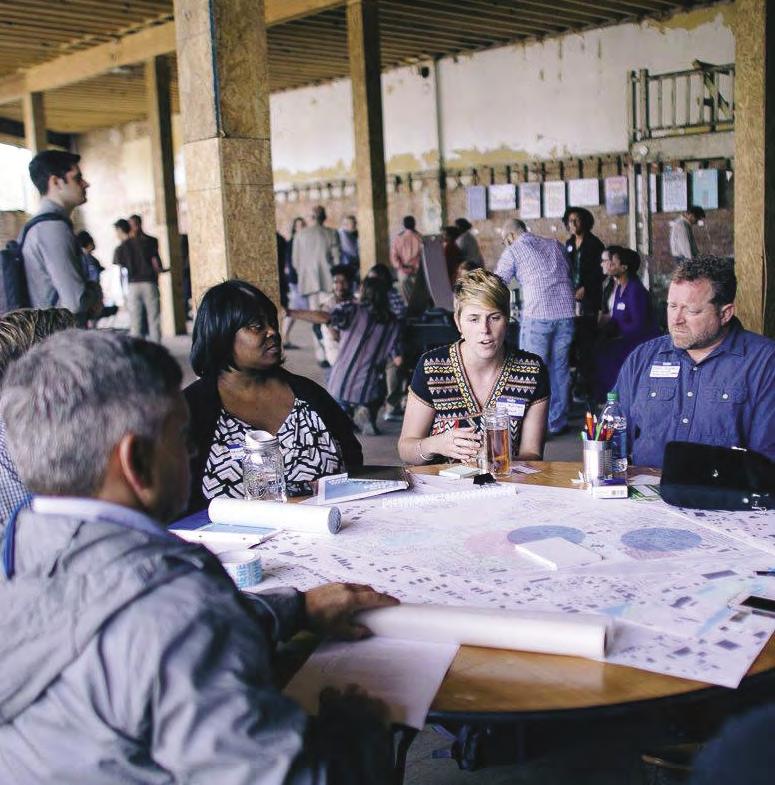
Studio Everything: Following a GHC artist residency, Rondell Crier secured outside funding to keep his Studio Everything going, serving local youth
FROM PLANNING TO PARTNERSHIP
Recruited Habitat for Humanity’s Neighborhood Revitalization to help support residential improvements

Worked with Sherman Reservation National Park to connect Glass Street to the Greenway
Launched Active Trails to help get local kids more comfortable in the great outdoors
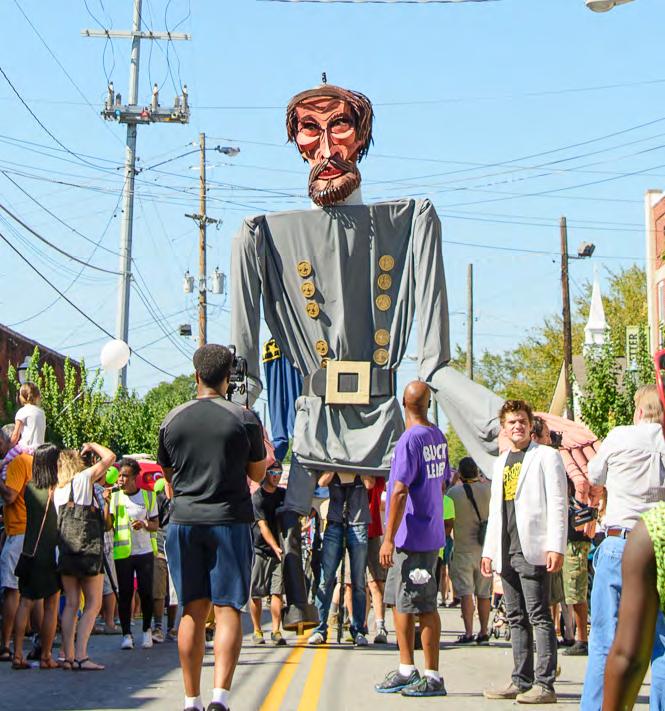
Recruited Shaking Ray Levi Society and artist Wayne White to host a puppet parade during Glass Street LIVE
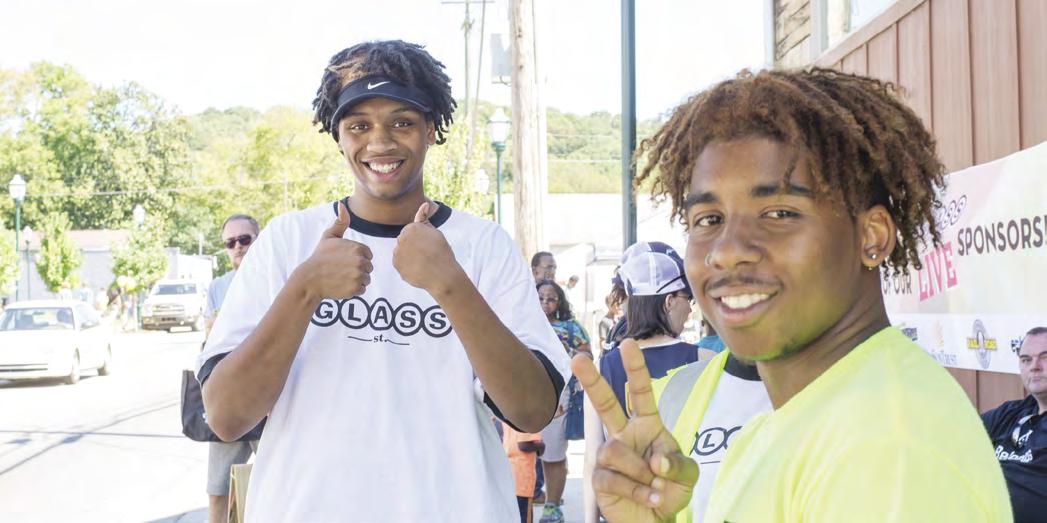
Hosted our largest Glass Street LIVE block party yet
2017FROM CELEBRATIONS TO STREET-LEVEL PROGRAMS
Hosted the Highlight Festival , a 3-day party on the vacant Harriet Tubman site featuring The Pool, Gospel on Glass, local hip-hop and spoken word performances, and a DJ
Continued to host GNN meetings as well as beautification blitzes
Partnered with green|spaces on a power program to reduce residents’ energy bills
Residents took the lead on an annual Christmas Party and handled all details
Organized early plantings and streetscaping on Chamberlain Avenue
2016
Guide to Community Organizing, a program that: Answered to resident-identified needs for neighbors to be involved in development
FROM NEIGHBORHOOD PRIDE TO NEIGHBORHOOD PULL
Launched Neighborhood Pride Campaign in partnership with Habitat for Humanity, including:
• • •
Addressing resident needs
Creating banners and yard signs to showcase pride in Glass Farm

Community-led branding process
Worked with the property owner to turn a vacant building into a new GHC HQ and further renovate a historic Glass Street space for use by local business
Turned streetscape focus to the intersection of Dodson Avenue and Glass Street
Hosted planning dinners for neighbors to share ideas for the Dodson plan (formalized but never adopted)
Advocated for and helped recruit a new grocery store after a local shop was closed by the health department
FROM CITY PLANNING TO LOCAL ORGANIZING
With many housing improvements underway , questions arose around whether GHC should invest in properties to avoid encroachment of gentrification and slumlords

In response, we launched Sway: The People’s
Provided a curriculum for working WITH communities, not FOR them
Taught principles of community organizing
Brought live training sessions to the neighborhood
Recruited 5 residents and 5 artists to complete the curriculum and create a project together, showcased at Glass Street LIVE
Business on the Rise

We were thrilled to celebrate the entrance of new businesses and opportunities launched by and for residents in 2019/2020:
• • • • • • • • • •
All Good Coffee Shop & Used Book Store opened and resident-owner renovated storefronts
Nippon Paint announced a new facility in area, creating 150 jobs over 5 to 7 years
Millennial Nail Bar, Chattanooga’s first Blackowned nail salon, opened on Glass St.
The Village Church & Purpose Point, a community-focused church and health clinic, opened in the neighborhood, bringing more resources to residents
Save A Lot opened and brought groceries and other retail to residents
Hosted Stir It Up worksho p to make Chattanooga’s “River to Ridge” Area 3 Plan actionable at the local level
Created list of ideas and priorities from the workshop and brought these to residents to set goals for 2020 and beyond
Glass Street LIVE was hosted and led entirely by neighborhood committee
2018
2019
FROM BIG GOALS TO NEW REALITY
Produced Through Glass, an arts response to the Covid-19 pandemic and subsequent lockdown, that connected people while remaining socially distant
Emphasized the importance of racial equity in our work; conducted formal training for board members and staff and issued a public statement on GHC position towards racial justice
Hosted Planning by Doing workshop to improve connectivity, comfort, and access across Glass Street near Dodson & Glass intersection, coined the Glass Street Gateway
Recruited Build It Green program from green|spaces to work in former bike co-op space
Hosted Meet and Eat community-building events on Zoom to keep community members engaged in the midst of the pandemic
Installed a temporary vertical street park as a pilot to test for a potential future semi-permanent park
Worked closely with Save A Lot grocery store as a new neighborhood partner
Partnered with Build It Green to weatherize homes, contribute to residential improvements, and create a pipeline for new training and jobs in the area


Worked with the community to bring Glass Street LIVE back to the block

Created a transition plan to hire Daniel Gamble as the new community liaison Actively fundraised to help celebrate and support the community’s future work
FROM ZOOM CALLS TO STREET-LEVEL CELEBRATIONS
Launched Advisory Council of residents and business owners to vet community programming and complete the SWAY curriculum
Launched Art Means Business , a grant program to invest in local businesses

Organized Asphalt Art Mural on Crutchfield Street in front of new Save-a-Lot and created community programming around its creation to highlight walkability
HAND OFF TO COMMUNITY
In our 10th year, we are going back to the community this organization was intended to serve to see what part of our collective legacy continues and which parts of community building can live on. GHC is currently in the process of turning this organization and its resources over to the council of neighbors who will work together over the year to decide next steps.
2020
2021
2022

What can't be Lost
IT IS CRITICAL TO ACKNOWLEDGE THAT THE FOUNDERS OF THIS ORGANIZATION
WERE NOT INVITED TO THE GLASS FARM NEIGHBORHOOD. WHILE WE ARRIVED HERE WITH A GENUINE DESIRE TO GIVE TO THE COMMUNITY, IT WAS THE GENEROSITY OF OUR NEW NEIGHBORS THAT EMPOWERED US, NOT THE OTHER WAY AROUND.
We listened, and we learned that Glass House Collective will have been its most effective and equitable only when it has been fully adopted by the community and put out of business. At the time of publication, we are doing just that: turning this organization and its resources over to the council of neighbors who will carry on its legacy of community building and advocacy.
This transition comes at a time in history and with a consciousness that demands its necessity. In 2020 our community, and our world, put the issue of racial equity and justice front and center for our organization. Like so many, we’d been deeply troubled by the murder of Black Americans year after year. George Floyd, Breonna Taylor, Trayvon Martin, Philando Castile, Eric Garner, and hundreds more. But as a movement around racial justice swelled, we understood that as a multiracial team with white leadership, we not only had a responsibility to say their names but to understand our role in a system that made their murders possible in the first place.
We invested in developing a new consciousness around white advantage and supremacy in placemaking — particularly the consequences it can have in predominantly Black communities like Glass Farm. This meant having raw conversations on our team and across our community. It meant looking within, to understand how each of us individually has contributed to, benefitted from, or been victimized by white supremacy. And it meant owning up to the ways in which GHC may have produced unintended harm for our neighbors, particularly around access and equity.
For example, we know that it is through white advantage that GHC has been able to unlock certain resources and investments for this community — which comes with a heavy feeling of complicity and responsibility. We’ve also been intentional about how those investments are used though, by actively investing in Black artists and helping demonstrate their important role as both creatives and community strategists. We know that one does not legitimize the other, but we are actively engaged in ensuring that racial justice plays a primary role in all we do, always.
We have been proud to play a connective role both within and beyond the Glass Farm community, but we are just as proud to be stepping back, acknowledging the full agency of the legitimate owners of the future of this neighborhood: its people.
GLASS HOUSE COLLECTIVE








Council
The Glass House Collective Advisory Council was established in 2021 in an effort to build community power. Council members -- each one passionate about the Glass Farm neighborhood -- have played an active role in programming and decision-making. They’ve also lent their unique community knowledge to help create neighborhood initiatives -- and on top of it all, invested their time in learning the art of community organizing. Now they embark as the leadership of this next chapter of the story of this community.
Advisory
Tina Stewart Business Owner
Rosalyn Stewart-Kalaukoa Business Owner
Ricardo Nache Community Partner
JaMichael Jordan Pastor
Latoia Glatt Business Owner
Deborah Bledsoe Resident
Jamila Dunigan Resident
Audrey McClure Resident
COLLECTIVE IMPACT // 79
Reflections

From the beginning, Glass House was an experiment.
The idea of having arts and culture at the table of neighborhood change was new to Chattanooga, and new to everyone who joined in the cause back in those earliest days. What we felt sure of was that as a collective, we could empower this community in a way that wasn’t possible as individuals.
REFLECTIONS // 81
WHEN IT IS THRIVING AT ITS VERY BEST, THAT POWER CAN BE DESCRIBED AS: AGENCY.




What we found was that profound power comes from creatives unlocking the meaning and reflecting the narrative of what a community is, and what it hopes to someday become.
Each relationship that this work has developed was built with the goal of creating agency. Each connection, each friendship, each partnership, each collaborative success, and even each mutual loss is part of the patchwork of people who are this collective. Had any one person not participated, had any one resident not engaged, had any one designer not lent their expertise, had any one business not been supportive, had any one partner not joined the effort, then the work -- the community -- would be lesser for it today. It is with deep gratitude that we reflect on this past decade, and our shared story.
Together we were able to co-create a body of knowledge and understanding about this work: what can be achieved, and how best to do so. It is incredibly rewarding to see this same work now being done in neighborhoods across Chattanooga and around the country, and it is a monument to the contributions of everyone who has been a part of Glass House Collective, Glass Street, and the Glass Farm neighborhood past and present, that their legacy of community-building will live on in such an impactful way.
Together, we were able to nurture an authentic livelihood here, one rooted in this place and expressed in terms meaningful to this unique and valuable community. We have accomplished so much, and have so much to take pride in. The past ten years have proven the power of creative placemaking to increase pride and strengthen purpose. As this book has attempted to document, this community has risen together again and again.

Yet there will always be ways that this community can do more, for each other and for the future of East Chattanooga. The next steps of this collective will be through a season of change, as the community steps into its full leadership of this work. With a collective approach, a network of willing partners, and the shared success of the community at heart, the work will indeed continue. We remain members of the agency of change in this special part of our city.


REFLECTIONS // 83
Thank You!
OUR NEIGHBORS
Aaron Adams, Abigail Emerson, Al Shannon, Alice Caldwell, Allen Shropshire, Amanda Mitchell, Amari Johnson, Andre Robinson, Asia Johnson, Audrey McClure, Belinda Thornton, Betty Patterson, Brandon McDonough, Carmen Davis, Charmer Johnson, Chip Brown, Christine Yeagley, Chrystion McKibbon, Clarence Smith, Cora Lanier, Cora Lanier, Dale Grisso, Dan Myers, Daniel Crlencic, Danna Forrester, Darrell Martin, David Raley, Deborah Bledsoe, Desia Clements, Don Gaither, Dr. Everlena Holmes, Edna Wellington, Enora Moss, Erika Holmes, Etta Knipes, Fanetta McCain, Frances Martin, Frederick Flach, Gail McKeel, Gerald Robinson, Glenda Welcher, Gloria Coleman, Harold Guenthner, James Cordell, James Moreland, Jamila Dunigan, Janette Richie, Jeffery Evans, Jermaine Pearson , Jerry Short, Jimmy Wright, Joe Lautigar, John Molthen, Johnnie Ware , Johnny Patman, Josh Livingsoton, Joyce Rogers, Joyce Watson, Katie McCallister, Larry Hines, Latoia Glatt, Lee McWhirter, Maria Bradley, Mark Colen, Mattie Crawford, Melanie Esquer, Michael Goins, Mildred Jones, Michael Long, Molly Brady, Naomi Dedmon, Patricia Northern, Paula Wilson Miller, Priscilla Ford, Ramond Pace, Romana Lagradamada, Ryan Keller, Shanece Treggs, Sheena Benavente, Steve Brown, T.J. Mitchell, Tanya Cochran, Thomas Miller, Tiffanie Trouble, Tinica Caperton, Travis Yeagley, Trish Rutledge, Verlene Middlebrooks, Veronica Graham, Walter Harmon
OUR ARTISTS
127 Press, 2DeepWithin, Aaron Cole, Adrian Lipscomb, Amy Brauer, Andrew Mollenkof, Andrew Travis, Annie Huntington, Anthony Wiley, Art 120, Ashley Clark, Ashley Folkner, Ashley Worley, Ashton Lance, Austin Reed, Ayelet Emma Flynn, Ayesha Meriweather, Benjamin Chase, Beverly Bell, Big Buffs 92 BBQ, Bill Ortwein Signs, Inc., Blake Wright, Brett Hunter, Brian Gober, Brian Beise, Bryan Dyer, Caleb Golson, Caleb Ludwick, Caleb Timmerman, Cameron Van Dyke, Cameron Williams, Carl Caldwell, Casey Hyde Photography, Casey Yoshida, Cassie Terpening, Catherine Woods, Ceara O'Leary, Cecil Daryl Thetford, Charles Brouwer, Charlie Newton, Chelsea Conrad, Christopher Weed, Clark Brewer, Colin Andrew Mollenkof, Color & Taste Photography, Corey Prather, Courtenay Cholovich, Daniel Skolfield, Dannita Noble, David Ruiz, Davy Granberry, Devante Williams, Devon Kronenberg, Dylan Fuller, Elea Wright, Elizabeth A. Vandergraph, Elizabeth Williams, Emily Talley, Emily Whitworth, Eric Finley Jr., Erika Roberts, Fancy Rhino, Folk School of Chattanooga, Gabrielle Blades, Gary Hamilton, Genesis the Greykid, Geoffrey Meldahl, Hayden Monfette, Heather Huston, Hollie Berry, Horace Bledsoe, Hunter Franks, Hysinger Design & Illustration, Jaime Smialak, Jake Ketterer, James McKissic, Jared Hueter, Jazmine LeBlanc, Jenison Owns, Jennifer Holder, Jessica Erin McFarland, Joda Thongnopnua, John Hensler, John Moore, John S. Adams Jr., John Taylor VanderHorst, John Wesley Giglio, John Whaling, Jonathan Dean, Jonathan Hood, Jordan Scruggs, Joseph Miller, Joseph Schlabs, Joshua Jorgensen, Joshua Wright, Josiah Golson, Juanita Montgomery, Jules Downum, Justin Butts, Karla Felecia Scaife, Kate Warren, Katie Anne Holden, Katie Hargrave, Kayla Green, Keely Stockett, Keenan Daniels, Keif Schliefer, Kelly Fitzgerald, Kelly Lacy, Kenneth Munoz, Kenny Morgan, Keren Beddoe, Kerry O'Connor, Kevin Bate, Kinnawa Kaitivi, Kofi Mawuko, Kourtney Brown, Kristen Jeffers, Laura Bohon, Laura Little, Laura Thatcher, Levar Wilson, Lindsey Wilke, Liza Blair, Lon Fynn Glover, Mace Carmichael, Machelle Booker, Mallory Baches, Maranda K. Stebbins, Marcellus Barnes, Marcus Ellsworth, Marcus Price, Mark Walter, Mary Ann Twitty, Mary M. LaVoie, Matt Reiter, Matthew D. Adams, Matthew Dutton, Maurice Cox, Meghan O'Dea, Merrell McGinness, Michael Goins, Michael Mahaffey, Michael Prater, Michael Twitty, Mike Lydon, Miki Boni, Nicholas Lutsko, Nicholas Turner, Nicky Falkenhayn, Olga de Klein, Olivia Bradley, Olivia Reckert, Our Luck Print, Petra Moraczewski, Phillip Allen, Phillip Jones, Pop-up Project, Quintin Perry, Rebekah Mawuko, Reed Schick, Reginald Clack, Reis Costa, Ricardo Moody, Ricardo Morris, Roeneisha Anderson, Rondell Crier, Sabrina M. Crarey, Sally Bacon, Sally Morrow, Sarah Ervin, Sarah Page, Shaking Ray Levi Society, Shaun LaRose, Shawanna Kendrick, Sheena R. Benavente, SIV Creative Services, Skwalking Heads Production, Steve Lyles, Steven Brown, Strat Parrott, Susanne M. Bowling, Tavis Salazar, Taylor Kinser, Travis Hitchcock, Treyzz, Veronica Park, Veronique Bergeron, Wayne Williams, Wes Mohney, Weston Lambert, Widgets & Stone, Will Dowdy, William Myles Freeman, Xavier Bledsoe, Zachary Reynolds
OUR PARTNERS
Adrian Lipscombe, AIA Chattanooga, AIGA Chattanooga, Akosua Cook, Alexa Lara, Ana May, Ann Coulter, Archway, Art120, Ashanti's Hair Designs, Ashley Conrad, Austin Sauerbrei, Avondale Neighborhood Association, Battery Heights Neighborhood Association, Bert Kuyrkendall, Bigg Mark, Bill Rush, Billy Reynolds, Bishop Freddie Hambrick, Blythe Bailey, Bob Franklin, Bob McNutt, Brad Bennett, Bridge City Community, Brush, Paint, and Sip, Bruz Clark, Build it Green, Build me a World, CALEB, CARTA, Cat Collier Martinez, Cate Irvin, CDOT, Ceara O'Leary, Charles Adamson, Chattanooga Department of Transportation, Chattanooga Design Studio, Chattanooga Hamilton County Regional Planning Agency, Chattanooga Neighborhood Enterprise, Chattanooga Neighborhood Arts Partnership, Chattanooga Organized for Action, Chattanooga
WE HAVE BEEN FORTUNATE TO WORK WITH AND LEARN FROM A LONG LIST OF NEIGHBORS, ARTISTS, VOLUNTEERS, COMMUNITY LEADERS, AND PARTNERS. We are deeply grateful for every moment spent sharing, responding creatively, and learning with us. The mission and outcomes described in this report are not ours, they belong to the Glass Farm community.
Police Department, Chattanooga Public Art Commission, Chattanooga Symphony and Orchestra, Chestnut Catalyst Group, Chris Woodhull, Christian Shackelford, Christina Mack, City Farms Grower Coalition, City of Chattanooga, Community Consultants, Community Foundation - City of Chattanooga Public Art Fund, Community of Christ Church, Cosette Consulting, Councilman Hakeem, Councilman Murphy, Councilwoman Coonrod, Cynthia and Stroud Watson, Dan Bowers, Daniela Peterson, David Barlew Architects, David Cook, David Stocks, Dennis Clark, Donald and Mary Sanderfur, Dwayne Marshall, East Chattanooga Improvement, East Chattanooga Rec Center, East Chattanooga Youth and Family Development Center, ELLA, Emerson Burch, Eric Asboe, Eric Atkins, Eric Myers, Estell Torrey, Every Valley Leadership Academy, Fancy Rhino, Everlena Holmes, First Step Christian Daycare, Fuller Hanan, Garth Brown, Gary Gaston, Geraldine Hendley, Girls Inc, Glass Farm Block Leaders, Glass Farm Neighborhood Association, Glenwood Neighborhood Network, Good Neighbor Network, green|spaces, Greg Heath, H&R Block, Habitat for Humanity, Hal Bowling, Hardy Elementary, Hefferlin + Kronenberg Architects, PLLC, Helen Burns Sharp, Highland Park Neighborhood Association, Hope for the Inner City, Isobel Ward, JaMichael Jordan, Jazzanooga/ RISE, Jeff Pfitzer, Joel Tippens, John Bilderback, John Bridger, Johnny Ware, Jumaane Lanier, Justin Tirsun, Kahla Stewart, Karen Hundt, Katelyn Kirnie, Katherlyn Geter, Kathleen Nolte, Ken Smith, Kerry Hayes, Kim Bonds, Kim Krause, Lakweshia Ewing, Latoia Glatt, LAUNCH, Laura-Margaret Jones, Laura Dunn, Lee Progress Barbershop, Lincoln Park Neighborhood Association, Lisa Pinckney, Liza Soydan, Mace and Carmichael, Macon Toledano, MaeClaire, Maeghan Jones, Make Beautiful, Mallory Baches, Marie Mott, Mark Making, Mary McSears, Mason Lodge, Michael Barielle, Michael Gilliland, Michael Long, Michael Walton, Mike Watkins, Nathaniel Bankhead, National Park Partners, National Park Service, Nello McDaniel, New Blue Construction, Noel Durant, Outdoor Chattanooga, Peggy Patprick, Peggy Townsend, Progress Barber Shop, Public Art Chattanooga, Range Projects, Reach One Teach One, Regional Ruff, Ricardo Nache, Rick Wood, River City Company, Ron Lowe, Rosalyn Stewart-Kalaukoa, Sanwell Public Relations, Sara Cross, Save A Lot, Set In Stone, Inc., Sherrell and Shelley, Soundcorp, Southeast Conservation Corps, Stephanie DeOlloqui, Strat Parot, Street Plans Collaborative, Inc., Studio Everything, Tamara Dillard, Tenesha Irvin, The Chattery, The Civic Hub, The National Park Service, The Village 2800, The World's Church of the Living God, Thomas Palmer, Tiffanie Robinson, Tim Andrews, Tina Stewart, Tiny Giant, Tomekia Moore, Travis Lytle, Trust for Public Land, U.N.I.T.Y., United Way, W.M. Whitaker & Associates, Wheeler Ave Neighborhood Watch, YMCA, Yolanda Putman, Zy'Mori Studios



OUR FUNDERS
Aggie Toppins, Alan Baird, Alice Smith, Alimentari, AMA Architects, American Motorcycle Towing, Aniya Clemmons, Ann Weeks, Anne Bright, Ansley Defoor, Antibes, Artplace America, Artsbuild, Ashlee Patten, Ashley Finch, Astre Foundation, Avery Patten, Benevity Fund, Bethany Patten, Bloomberg Philanthropies, Brandon Ellis, Buck Gentry, Carla Silas, Carol Seaberg, Caroline Thomas, Causeway, Chambliss, Bahner, & Stophel, P.C., Charles Mayhem, Charles Redlick, Charlotte Landis, Chattanooga Neighborhood Enterprise, Chattanooga Rugby Team, CHI Memorial, Christina and Tom Montague, City of Chattanooga, Coca Cola Bottling Company, Community Foundation of Greater Chattanooga, Currin Family, Daniel Gamble, Danna Bailey, Diana Summerlin, Donna Willams, Dorothy Dubose Engsberg, Douglas Musicaro, Edd Kirby Adventure Cars, Educational Foundation of America, Elliott Davis Decosimo, Enterprise Community Partners, EPB, Erlanger Hospital, Fast Stop, First Christian Church, Fitzgerald Family, Flying Squirrel, Footprint Foundation, Frances McDonald, Frank Pazera, Gail McMahon, Gallery 1401, Garnet Chapin, Garth Brown, Goodhew, Greg Ross, Hamico Foundation, Haunt Mozilla, Heaven & Ale, Heidi Hefferlin, Helen Johnson, Jack McKee, Jacob D'angelo, Jacob Schubert, Jay Branum, Jay Mills, Jeff Pfitzer, Jennifer and Fielding Atchley, Jennifer Holder, John and Imogene Konvalinka, John Bailey, Josh McManus, Karenza Pentiah, Karin Hawkins, Kay & Steve Parish, Keely Gilliland, Keith Landrum, Knight Foundation, Lamp Post Group, Larimore Roberts, Lauren Farr, Lillian L Colby Charitable Foundation, Lora Giampetruzzi, Lululemon Chattanooga, Lyndhurst Foundation, Main Street Meats, Margaret Finnegan, Mark & Kristen Begot, Marti Owensby, Martina Guilfoil, Matt Averyhard, Matt Park, Max Fowinkel, McCallie School, McKenzie Calhoun, Melanie Singer, Michael Pan, Michelle Hunter, Mike Todai, Monica Kinsey, Moses Freeman, Nassaar Jaser, National Park Foundation, New Blue Construction, Niedlov's Breadworks, Office Furniture Warehouse, Owen Boger, Parkridge Medical Center, Patrick and Brenna Kelly, Paul & Gwen Green, Peter Deming, Pfeffer Torode Architecture, Pinnacle Financial Partners, Project for Public Spaces, River City Company, Robert Finley Stone Foundation, Robert Steel, Samuel Currin, Shearburn-Allen Family, Sophie's, Southern Sqweeze, Southern Star, Stephen O'Neil, Steve Gaines, Suntrust Foundation, Susan Lazenby, Tamara Dillard, Tennessee Stillhouse, The Benwood Foundation, The Bitter Alibi, The Educational Foundation of America, The Generosity Trust, The Hand Foundation, The Outdoor Foundation, The Patten Group, The Robert Finley Stone Foundation, Thomas Wiegand, TN Arts Commission, TN Valley Railroad Museum, TomTom Foundation, Tucker Foundation, Volswagen Group of America, Warburg Pincus, Whitney Drayer, William Konvalinka


OUR STAFF AND BOARD
Aggie Toppins, Alexis Willis, Annette Allen, Ashley Finch Noojin, Audrey McClure, Blake DeFoor, Buck Gentry, Carlos Hampton, Catherine Colby, Daniel Gamble, Deborah Bledsoe, Enora "Nori" Moss, Erika Roberts, Erika Robinson, Jamie Barbeauld, Jared Hueter, John McCabe, Katherine Currin, Kevin Smith, Lauren Lowery, Lillie Wills, Logan Threadgill, Lynesha Lake, Mary Barnett, Mary Carlson, Monty Bruell, Nicole Lewis, Peter Murphy, Rondell Crier, Sarah Weeks Robbins, Tara Poole, Teal Thibaud, Vanessa Jackson, Whitni McDonald, Zach Atchley









































































































